13.1 Contemporary Government Regimes: Power, Legitimacy, and Authority
Learning outcomes.
By the end of this section, you will be able to:
- Describe the nature of governing regimes.
- Define power, authority, and legitimacy.
- Explain the relationships among power, authority, and legitimacy.
- Discuss political history and contemporary political and legal developments surrounding governing regimes.
A government can be defined as a set of organizations, with their associated rules and procedures, that has the authority to exercise the widest scope of power —the ability to impose its will on others to secure desired outcomes—over a defined area. Government authority includes the power to have the final say over when the use of force is acceptable, and governments seek to exercise their authority with legitimacy. This is a complex definition, so this section unpacks its elements one by one.
A government both claims the right and has the ability to exercise power over all people in a defined geographic area. The leadership of a church or a mosque, for example, can refuse to offer religious services to certain individuals or can excommunicate them. However, such organizations have no right to apply force to impose their will on non-congregants. In contrast, governments reserve for themselves the broadest scope of rightful power within their area of control and can, in principle, impose their will on vast areas of the lives of all people within the territories over which they rule. During the COVID-19 pandemic, only governments both claimed and exercised the right to close businesses and to forbid religious institutions to hold services. The pandemic also highlights another feature of governments: almost all governments seek to have and to exercise power in order to create at least minimal levels of peace, order, and collective stability and safety.
As German social scientist Max Weber maintained, almost all governments seek to have and to enforce the right to have the final say over when violence is acceptable within their territory. Governments often assert what Weber called a monopoly on the right to use violence , reserving for themselves either the right to use violence or the right to approve its use by others. 1 The word monopoly might be misleading. In most countries, citizens have a right to use violence in self-defense; most governments do not maintain that they alone can exercise the acceptable use of violence. Where the government recognizes the right to use violence in self-defense, it will seek to reserve for itself the right to decide when, in its judgment, that use is acceptable.
Imagine a landlord confronting a tenant who has not paid their rent. The landlord cannot violently seize the renter and forcibly evict them from the apartment; only the police—an agency of the state—can acceptably do that. Nevertheless, the law of many countries recognizes a right of self-defense by means of physical violence. In many US states, for example, if a person enters your house unlawfully with a weapon and you suspect they constitute a threat to you or your family, you have a broad right to use force against that intruder in self-defense (a principle that forms the core of the “ castle doctrine ”). In addition, private security guards can sometimes use force to protect private property. The government retains the right to determine, via its court system, whether these uses of force meet the criteria for being judged acceptable. Because the government sets these criteria, it can be said to have the final say on when the use of force is permissible.
Authority is the permission, conferred by the laws of a governing regime, to exercise power. Governments most often seek to authorize their power in the form of some decree or set of decrees—most often in the form of a legal constitution that sets out the scope of the government’s powers and the process by which laws will be made and enforced. The enactment of codes of criminal law, the creation of police forces, and the establishment of procedures surrounding criminal justice are clear examples of the development of authorized power. To some degree, the constitution of every government authorizes the government to impose a prohibition, applicable in principle to all people in its territory, on certain behaviors. Individuals engaging in those behaviors are subject to coercive enforcement by the state’s police force, which adheres to defined lines of authority and the rules police departments must follow.
Governmental regulations are another type of authorized government power. The laws that structure a regime usually give the government the authority to regulate individual and group behaviors. For example, Article 1 Section 8 of the US Constitution authorizes the federal government to regulate interstate commerce. When large commercial airlines fly individuals across state lines for a fee, they engage in interstate commerce. The federal government therefore has the authority to regulate airline safety requirements and flight patterns. Pursuant to this authority, the federal government has established an agency, the Federal Aviation Administration (FAA), to issue these regulations, which are ultimately backed by the state’s coercive enforcement power.
Weber argued that those who structure regimes are likely to choose, on the basis of the regime’s own best interests, to create authority that is clearly spelled out in a regime’s constitutional law. 2 When lines of authority in the government are clear, especially in the context of the state’s criminal law, the people living in a regime are less fearful of the state. This helps the state secure the people’s support. When the scope of the government’s authority is clear, people can understand how their government is structured and functions and are therefore less likely to be surprised by governmental actions. This can be especially important for the economy. To follow the example above, if laws regulating the private ownership of commercial airlines are constantly open to unexpected change, some people may be wary of working in the industry or investing their money in these companies’ stock. Predictable governmental action can encourage these investments. With increased economic activity, the government can tax the productive output, amassing resources to help it achieve whatever its goals might be. In addition, clearly defined structures of authority in the form of stable bureaucratic institutions allow a government to exercise power more efficiently and cost-effectively, once again enabling it to amass more resources to serve its objectives. 3
The use of physical force to directly restrain behavior is just one of the ways governments exercise power. Governments also tax. In a sense, the taxing authority of government is a necessary corollary of its authority to impose behavior-restricting rules: almost all governments must derive revenue through taxes in order to finance the maintenance of their laws and to ensure peace and public order. However, that authority also allows governments to exercise power to achieve a wide variety of ends, funding everything from foreign wars to a social safety net or a set of social programs. Taxation is another way governments regulate people’s behavior: if you don’t pay your taxes, the government is authorized to punish you—a principle true across the world, even if the levels of enforcement for not paying taxes vary across regimes.
The authority to tax illustrates another aspect of governmental power: the use of authority to shape society by creating incentives for particular kinds of behavior. In the United States, the federal tax code enables taxpayers to deduct large charitable donations from their taxable income as a way to encourage individuals to give to charities. Additionally, homeowners can deduct the interest they pay on their home mortgage, thereby reducing their annual federal tax obligation. This use of government power is meant to encourage people to own homes rather than rent. In the United States, at least, the federal government has encouraged homeownership due to a belief that homeownership helps people build closer ties with and involvement in local communities and thus increases civic participation, and that owning a home correlates with greater levels of long-term savings, which can provide individuals greater financial security in their retirement. 4 (For some people, their house is their largest asset, which can help to finance their retirement.) Conversely, governments can impose “sin taxes”—that is, taxes on products like alcohol and cigarettes, discouraging their use. Some lawmakers have proposed levying higher taxes on bullets to discourage gun violence, and some areas have taxed sugary soft drinks to discourage their consumption as a way to improve public health. 5

Show Me the Data
Beyond taxation, governmental leaders can use their office to influence public opinion. Governmental authorities are often authorized to use the government’s assets to promote their policies: the president of the United States, for example, is authorized to use Air Force One (the presidential jet) to travel the country in order to promote policy proposals. (Presidents are not, however, allowed to use Air Force One for free to conduct political fundraising.) Additionally, members of the United States Congress are authorized to send letters to constituents, free of charge, describing or defending the policies they support. Tools like these allow governments to exercise the power of influence and persuasion. The chief executive is usually the governmental official who takes the greatest advantage of this form of power. In the United States, presidents such as Teddy Roosevelt became famous for skillfully using the “ bully pulpit ,” that is, the power of the president to shape the opinions of the population and, through this, potentially to influence members of other branches of the government, especially elected legislators.
Presidents and prime ministers often give speeches or issue proclamations to exert this power. President Barack Obama, for example, following a long tradition in American politics, spoke often of what “we as Americans” value as a way to persuade the populace to support the policy agenda of his administration. Take the following example from one of Obama’s speeches. In the speech, he defended his administration’s decision to change the priorities of federal immigration officials to less rigorously enforce laws requiring the deportation of undocumented individuals when those individuals entered the country as children—the Deferred Action for Childhood Arrivals, or DACA, program. Arguing that children brought to the country by their parents should not have to live in fear of deportation, Obama remarked:
“My fellow Americans, we are and always will be a nation of immigrants. We were strangers once, too. And whether our forebears were strangers who crossed the Atlantic, or the Pacific, or the Rio Grande, we are here only because this country welcomed them in and taught them that to be an American is about something more than what we look like, or what our last names are, or how we worship. What makes us Americans is our shared commitment to an ideal—that all of us are created equal, and all of us have the chance to make of our lives what we will.” (emphasis added) 6
By using rhetoric that attempts to define the national ethos, governments can seek to exercise power by shaping the population’s sense of itself and its place in history.
Most governments establish authority not only to exercise power, but also in the pursuit of legitimacy. Legitimacy can be seen from two different vantage points. Following Weber, the term is often used to mean the widespread belief that the government has the right to exercise its power. In this sense—which can be called broad legitimacy —the concept describes a government trait. Legitimacy can also be seen from the perspective of individuals or groups who make determinations about whether their government is or is not legitimate—that is, rightfully exercising power, or what can be called judgments about legitimacy . In either sense, legitimacy is measured in perceptions of the rightfulness of government actions—the sense that those actions are morally appropriate and consistent with basic justice and social welfare.
It is quite possible for a small group or a small set of groups to conclude that their government is illegitimate and so does not have the right to exercise authorized power even as the vast majority think that government is rightfully exercising authorized power. In this case, since the dissenting group is small and the great majority see their government as legitimate, the state can be deemed broadly legitimate. Broad legitimacy, therefore, is defined not as unanimous agreement by the people that a government’s authority is rightfully exercised, but simply as a broad sentiment that it is.
Finding Legitimacy: What Does Legitimacy Mean to You?
In this Center for Public Impact video, people from around the world talk about what government legitimacy means to them.
Legitimacy is a vague concept. Citizens’ judgments about legitimacy entail the often-difficult determinations of what is or is not rightful and thus consistent with morality, justice, and social welfare. Judging rightfulness can be a challenging task, as can the determination of whether a regime truly possesses broad legitimacy. Though you cannot always say for certain that a government truly has broad legitimacy, broad illegitimacy is often easy to detect. Indications of governments that do not have broad legitimacy can take many forms, including sustained protests, very low levels of trust in the regime as captured by polling data, and widespread calls for revising or abandoning the constitution.
The most effective governments, Weber argued, not only have laws that clearly authorize power but also have some substantial measure of broad legitimacy. Broadly legitimate governments can exercise power without the threat of popular rebellion, and the state can more readily rely on people to follow the law. These conditions can spare the government the cost of large standing police forces or militaries, and those resources in turn can be allocated in other areas. Unsurprisingly, most governments seek to legitimize their rule.
In the United States, many debates over rival understandings of law and public policy are not debates over legitimacy. For example, many groups in the United States disagree over certain tax policies; some want to increase taxes to pay for greater services, while others want to lower taxes to encourage economic growth. Yet those who oppose a particular tax law rarely refer to it as illegitimate since the law is recognized as coming from a process that has widespread popular support—that is, from the lawmaking process authorized in the US Constitution. Therefore, tax laws that many disfavor are usually not seen as illegitimate, but simply as unpopular or unwise and thus in need of change.
However, in the United States today, more and more debates surrounding law, public policy, and election results are expressed in terms of judgments of their legitimacy or illegitimacy. A true loss of legitimacy, either in the eyes of a small group or in the eyes of the broad populace, occurs only when a law is determined to be so wrong or harmful that it is not right for the government to enact it. In many cases in the United States today, allegations of illegitimacy contend not that a law or electoral result lacks legitimacy because the substance of the law or election outcome is so egregious that it is not a rightful thing for the government to do or to permit, but because they claim the US Constitution does not authorize the law or the process that resulted in a particular outcome.
Consider the 2020 election and debates involving the administration of President Joe Biden . Many supporters of Donald Trump hold that President Biden is an illegitimate president, 7 but they contend not so much that he is so unacceptable that his holding the office of president is inconsistent with morality, justice, and social welfare, but that the governmental officials in charge of running the 2020 presidential election process acted inappropriately or even, some contend, engaged in criminal ballot tampering. For these reasons, to them Biden’s current presidency is unrightful because they see the process by which he was elected as unauthorized. 8 Numerous post-election audits have found the allegations to be without merit. 9 In an April 2021 poll, about three-quarters of Republicans, a quarter of Democrats, and half of Independents indicated that they believe the 2020 election was affected by cheating. 10
These debates are complicated, and it is difficult to pinpoint the origin, rationale, and true motivation behind these judgments that the election results, for example, are illegitimate. What can be said is that there seem to be not only deeply rooted disagreements in the United States over what policies are best, but also deep disagreements about whether a variety of laws or governmental actions are in fact authorized by the Constitution—a development arising because of deepening disagreements among citizens about what the Constitution and the rules it contains actually mean.
Some public allegations that a law or electoral outcome is illegitimate in the sense that it is unauthorized may be mere covers for the genuine view that the laws or the electoral results are themselves unrightful, even if they were authorized. Those making such claims may not wish to be seen as protesting authorized governmental activity since to do so could make them appear lawless or even revolutionary.
The Legitimate Exercise of Power
In some cases, the constitutional law of a governing regime authorizes the suspension of established laws and regulations, allowing the government to act without defined limits on the scope of its authorized actions. A common way this can occur is in regimes that authorize the government to declare states of emergency that suspend the government’s adherence to the ordinary scope of authorized power.
There are strong reasons for states to resist invoking a condition of emergency. Clear lines of government authority, especially in the context of the state’s criminal law, tend to make people less fearful of the state, allowing the state more easily to call upon the people for support and thus enhancing the state’s legitimacy. Nevertheless, many regimes have the authority to declare emergencies—often in response to threats to public safety, such as terrorism—and to act in only vaguely specified ways during these periods.
45 Years Ago, a State of Emergency Was Declared in India
In 1975, during a time of social and political unrest, India’s national government declared a nationwide state of emergency, allowing the government to suspend civil liberties.
States generally see the establishment of public security as critical to their continued broad legitimacy: a state that cannot protect its people is likely to lose the widespread sentiment that it has the right to rule. Yet many states realize the potential negative consequences of unpredictable or unrestrained state action. For this reason, many regimes authorize the declaration of states of emergency , but only for limited periods of time. In France, for example, the president can declare a state of emergency for no more than 12 days, after which any extension must be approved by a majority vote of the legislature. 11 This power was enacted in response to terrorist attacks in 2015 and was renewed periodically until 2017. The state of emergency allowed, for example, certain otherwise unauthorized police procedures, such as searching for evidence without a warrant issued by a judge. 12 France’s law authorizing emergency declarations dates to the 1950s, and that it is fully authorized by the French Constitution and widely approved 13 illustrates that in some circumstances governing regimes can legitimately exercise sweeping and unstructured governmental powers. 14
Where there is broad public support, regimes may periodically and legitimately reauthorize states of emergency. Take, for example, the State of Israel. Israeli law authorizes two different forms of declarations of emergency, one that can be issued only by the legislature and one that can be issued by the government’s executive officials without the need for the legislature’s approval. The first form, which allows the government “to alter any law temporarily,” 15 can remain in effect for up to one year and can be renewed indefinitely. This allows governmental officials to use sweeping powers restricted only by the vague statement that emergency enactments may not “allow infringement upon human dignity.” 16 In addition, The Basic Laws of Israel allow the Israeli government—independent of a declaration of emergency by the legislature—to declare a condition of emergency. 17 These decrees can remain in effect for three months but can also be renewed indefinitely. 18 Pursuant to this authority, the government in 1948 issued an Emergency Defense Regulation that authorized the “establishing [of] military tribunals to try civilians without granting the right of appeal, allowing sweeping searches and seizures, prohibiting publication of books and newspapers, demolishing houses, detaining individuals administratively for an indefinite period, sealing off particular territories, and imposing curfew.” 19 This regulation has been renewed every year since 1948; today it applies mostly to the West Bank. 20 Both forms of emergency decrees have broad support in Israel, 21 indicating the popular sentiment that the Israeli government has the right to invoke such sweeping and unrestricted protocols because of the widely held belief among Israelis that the country faces serious and ongoing threats.
Even when such declarations are authorized and have initial broad support, the extensive use of emergency decrees risks undermining the regime’s legitimacy. In the early 1970s, then-president of the Philippines Ferdinand Marcos tested the limits of using emergency declarations to claim sweeping powers. In General Order No. 1, issued on September 22, 1972, Marcos declared:
“I, Ferdinand E. Marcos, President of the Philippines, by virtue of the powers vested in me by the Constitution as Commander-in-Chief of the Armed Forces of the Philippines, do hereby proclaim that I shall govern the nation and direct the operation of the entire Government, including all its agencies and instrumentalities.” 22
As one scholar relates, Marcos “took great pains to ensure that his actions would align with the dictates of the law.” 23 The Philippine Constitution at the time allowed the president, in his role as Commander in Chief, to declare an emergency and to use emergency powers. 24 To ensure he could remain in office beyond the two four-year terms allotted to each president by the constitution, Marcos called for a constitutional convention, which was ratified by the population and which changed the position of president into that of a prime minister who could serve as long as the parliament approved. After an additional constitutional change in 1981 that made the office of president once again directly elected by voters, Marcos successfully ran for president, pledging to continue to exercise sweeping unrestricted powers. 25 Marcos has thus been called a “constitutional dictator,” 26 one who came to rule with unrestrained power through a popular constitution and as a leader who himself enjoyed wide popularity.
Martial Law in the Philippines
In 1972, the president of the Phillippines, Ferdinand Marcos, declared martial law. This video clip describes what led up to the proclamation and the extreme conditions in place in the Phillippines under martial law.
At least, that is, at first. Over time, Marcos’s support deteriorated as people tired of his often chaotic and increasingly cruel dictatorship. By 1986, his People Power Revolution saw the electorate turn on him, and the United States pressured him to respect the electoral outcome and leave office. 27
A regime that assumes long-lasting, sweeping, and only vaguely defined authority as the Philippines did under Marcos can become a police state (sometimes called a security state )—that is, a state that uses its police or military force to exercise unrestrained power. When states do not operate within clearly defined legal rules, political scientists say that the government in those states has little respect for the rule of law .
Governments may also exercise unauthorized but legitimate forms of power. Although the absence of authority can be grounds for judging an exercise of power to be illegitimate, this is not always the case. Examples of unauthorized but legitimate government activities tend to fall at two ends of the spectrum of public importance: governmental actions that are generally considered rather insignificant and actions that are deemed to be of tremendous importance, especially in grave moments of crisis.
On one end of the spectrum, as a result of the federal National Minimum Drinking Age Act of 1984, the legal age to purchase or publicly consume alcohol anywhere in the United States is 21. However, this law allows states to make exceptions to the age requirement for individuals under 21 who possess or consume alcohol in the presence of responsible parents. Not all states have created exceptions in their alcohol laws, and the possession of alcohol by anyone under the age of 21 is always technically illegal. 28 But in a number of these states there is such widespread sentiment that possession is acceptable in the presence of responsible adults that there is wide agreement that the state can exercise the unauthorized power to choose not to enforce the law under these conditions.
On the other end of the spectrum, during perceived moments of grave emergency, such as a dire terrorist threat, there may be broad agreement that the government may, legitimately exercise the unauthorized use of power. Princeton professor Kim Lane Scheppele notes that since 9/11 a number of world governments have made “quick responses [to terrorism] that violate the constitutional order followed by a progressive normalization.” 29 These actions might be limited in number, and the broader population may be unaware of their details and scope. Nevertheless, it is arguable that the population is aware that its government is taking unauthorized action in response to terrorist threats and that it supports the government’s right to do so.
The Illegitimate Exercise of Power and the Challenge of Revolutionary Change
Some regimes, though they have established lines of authority, may come to be broadly illegitimate over time. Throughout history, there are many examples of times when the sense that a regime was no longer legitimate led the people to revolt, either by sustained, widespread peaceful protests—such as in the Velvet Revolution in November of 1989 that led to the dissolution of the communist regime of Czechoslovakia—or by internal violent regime change—that is, the use of revolutionary violence. Revolutions intent on removing a constitution almost always seek to replace one constitution with another. Is there a standard of justice that transcends the constitutional law of a particular regime, a standard that can guide a people as they seek to free themselves from one constitution and replace it with another? Historically, in the Western political context, the standard of basic morality, justice, and social welfare has been the set of natural rights guaranteed by the natural law. More recently, the standard is referred to most often as fundamental human rights. (See also Chapter 2: Political Behavior Is Human Behavior and Chapter 3: Political Ideology .) The meaning of these concepts—natural law, natural rights, and human rights—is often contested, and this disagreement complicates any efforts to establish new constitutions to replace illegitimate regimes. Successful revolutionary change faces numerous challenges, including the fact that people might agree that a regime is not worthy of support, but their reasons for that opinion may differ. 30
In the 1930s and 1940s in India, Mahatma Gandhi employed civil disobedience to protest British imperil rule. One way a group can seek to change a law or even an entire governing system is to engage in civil disobedience , the nonviolent refusal to comply with authorized exercises of power. In the 1960s, civil rights groups such as the Southern Christian Leadership Conference led by Rev. Martin Luther King Jr. used civil disobedience to protest racial discrimination. Although both started out as small protest movements, they grew into movements capable of undermining the broad legitimacy of the governing regimes they opposed.
Methods of Developing Legitimacy
Widespread support for the right of the government to rule can come from a variety of sources. Max Weber argued that broad legitimacy develops in three primary ways. 31 The first of these is what he calls traditional legitimacy , where the governing regime embraces traditional cultural myths and accepted folkways. The United Arab Emirates can be considered an example of a regime with traditional legitimacy. Located in the far eastern section of the Arabian Peninsula, the seven small states that make up the UAE are joined together in a loose confederation, with each ruled by a monarch or emir. This system aligns with long-standing traditional practices of tribal chieftains associating together in a loose alliance to meet common objectives.
The second way legitimacy can accrue, according to Weber, is through charismatic legitimacy , when forceful leaders have personal characteristics that captivate the people. There are many examples of charismatic legitimacy throughout political history. Ruhollah Khomeini , a senior Shi‘a cleric who died in 1989, held remarkable appeal in Iran in the 1970s. Seen by many Iranians as a stern man of God, he was widely thought to be unaffected by the wealth, power, and corruption that so many Iranians saw as typifying the regime of the shah (or king) of Iran, Mohammad Reza Pahlavi . Khomeini was revered for his mysticism and his love of poetry. His personal magnetism played a large role in mobilizing Iranians to topple Pahlavi’s government and to replace it with the contemporary constitution of Iran, which establishes a Shi‘a theocracy , 32 a system of government in which religious leaders have authorized governmental power and possess either direct control over the government or enough authorized power to control the government’s policies. 33
Charismatic Che Guevara: Cuban Revolutionary
Revolutionary Che Guevara is revered in Cuba as an anti-establishment hero.
Weber’s third type of legitimacy is what he calls rational-legal legitimacy . This type of legitimacy develops as a result of the clarity and even-handedness with which a regime relates to the people. Take the example of Otto von Bismarck (1815–1898), who as the prime minister of Prussia forged a united German state. This new regime gained legitimacy not only because of the shared German culture of the formerly independent German states, but also because of the efficiency of its state bureaucracy, which established a uniform system of law administered by trained public servants.
Based on Weber’s analysis, a regime can secure legitimacy if the following are true:
- The regime solidifies and advances the material interests of a large percentage of the population.
- The regime advances deeply held moral and/or religious principles or advances strongly valued cultural traditions.
- The regime both supports religious, moral, or cultural values and advances the people’s economic interests.
- Based on an emotional sentiment, the people feel a strong emotional connection with the state.
- Based on a habitual respect for the government, the people unreflectively support the regime.
Legitimacy can be thought of as emerging from the agency of the people, who give their support to the regime either as a result of rational reflection, emotional attachment, or the acceptance of customary ways of relating to political power. However, one should not think of the agency of the people, by which they confer legitimacy on the regime, as something that is necessarily wholly independent of the actions of the regime itself. It is possible for a regime to shape the way people relate to it. Regimes employ different tactics toward that end, including government-controlled education, state control of the media and arts and entertainment sectors, and associating the regime, at least in the people’s perceptions, with the cultural or religious views predominant among the governed. As such, although some regimes may well enjoy broad legitimacy by the free choice of their citizenry, the possibility also exists that regimes gain legitimacy through what economist Edward Herman and philosopher and linguist Noam Chomsky call (in a different context) “ manufactured consent ”—that is, the shaping of the people’s response to the regime by state programs and activities designed to instill support for the regime, programs that might begin early in the citizens’ lives or that might affect citizens in subtle ways. 34 Examples of this can include widespread and rather blatant government propaganda , usually defined as misleading statements and depictions meant to persuade by means other than rational engagement, or subtle control over the content of what is taught in schools.
The contemporary government of the Eastern European nation of Belarus provides an especially vivid example of a regime seeking to manufacture consent through a coordinated effort to control access to information. Until the fall of the Soviet Union in 1991, Belarus was a part of the Soviet state. After it established independence from the defunct Soviet Union, Belarus adopted a constitution that—on paper at least—requires free and fair elections for major government positions and affirms freedom of the press. Upon taking office as president after his victory in the 1994 election, the current Belarusian president Alexander Lukashenko promised to allow broad civil liberties. 35 Yet, over the past 25 years, Lukashenko has exerted tremendous control over the media, including the internet. 36 Media content in Belarus is heavily restricted such that opposition voices are almost never depicted positively, 37 and the regime has used its control over the media to promote Belarusian independence and Belarusian nationalism. 38 It is in this context that Lukashenko has continued to be reelected. The support he receives can be seen as being, to a large degree, a function of his government’s control over the formation of public opinion. To this extent, Lukashenko has followed the tradition of communist nations such as the Soviet Union and the People’s Republic of China, which have a long history of controlling their people’s access to information while advancing throughout society the state’s preferred political messages. The exercise of manufactured consent may not always be so overt in other countries, but it may be just as effective.
Failed and Fragile States
When a state’s ability to exercise control such that it can provide minimal conditions of law, order, and social stability deteriorates to a precariously low level, it is called a fragile state . Fragile states still assert the authority to rule but have serious difficulties actually ruling. The erosion of a state’s legitimacy can lead to state fragility. A fragile state can also occur when a broadly legitimate state has its capacity to provide order depleted as a result of an external force, such as an invading army. 39
If a fragile state loses the capacity to provide minimal conditions of law, order, and social stability entirely, it becomes a failed state . A failed state can emerge either when a state has collapsed so thoroughly that it lacks any governmental power altogether or when a shadow government has emerged—that is, an organization not authorized or desired by the government asserting rule over an area that effectively displaces and serves the same function as the official government. In this situation, internal violent regime change can occur, for if the shadow government becomes strong enough, it can mobilize sufficient power to dislodge entirely the existing regime and install itself as the authorized governmental entity. It may in the process have developed broad legitimacy, or it may simply have sufficient military power to take over the government, possessing the power of government and imposing laws that authorize its rule but not enjoying the wide support of the populace. A fragile government is one that is at serious risk of failing in either of these two ways or of experiencing violent regime change.
In the early 2020s, a shadow government formed in large sections of Afghanistan , and the forces of that shadow government carried out violent regime change. From 1996 until 2001, the Taliban , an extremist Sunni Islamic movement, ruled the Afghan government. In 2001, in the wake of the 9/11 terrorist attacks orchestrated by Al Qaeda, a coalition of Western nations invaded Afghanistan. Due to concerns that the Afghan government had allowed the Al Qaeda terrorist network headed by Osama bin Laden to operate within the country’s borders, this coalition removed the Taliban from government. The coalition replaced the Taliban government with a governing regime that had considerable elements of representative democracy.
In early 2021, a shadow government led by members of the Taliban resurfaced in areas of Afghanistan. In some of these areas, the Taliban enjoyed wide popularity. Writing in January of 2021, the reporter Mujib Mashal described one such area, the city of Alingar:
“Alingar is . . . an example of how the Taliban have figured out local arrangements to act like a shadow government in areas where they have established control. The insurgents collect taxes . . . and have committees overseeing basic services to the public, including health, education and running local bazaars.” 40
In August 2021, the capital of Afghanistan, Kabul, fell to Taliban forces, and the more democratic regime collapsed. The Taliban has since consolidated its power, issued laws authorizing its regime, and sought to secure legitimacy among the broad Afghan population. Whether Afghanistan’s restored Taliban regime will endure remains an open question.
The current regime of Afghanistan represents a clear example of a fragile state. Fragile states either have a tenuous ability to keep the peace, administer court and educational systems, provide minimal sanitary and health services, and achieve stated goals such as conducting elections, or they are at risk of harboring within them rival organizations that can achieve these goals. Somalia is another example of a fragile state. 41 In more than 30 years of civil war, the regime governing Somalia has at times been at risk of failing to provide even a minimal level of security and stability. The condition in the country has stabilized somewhat from its low point in the early 1990s, when the risk of famine was so acute that the United States deployed military troops in Somalia to protect United Nations workers providing humanitarian relief in the country (a deployment that became controversial in the United States due to significant US military casualties). 42 Somalia, however, still shows signs of fragility. Although the Somali government scheduled national elections to take place in the summer of 2021—the first to be held in decades—these elections have been indefinitely postponed in the face of continuing instability in the region. 43
As an Amazon Associate we earn from qualifying purchases.
This book may not be used in the training of large language models or otherwise be ingested into large language models or generative AI offerings without OpenStax's permission.
Want to cite, share, or modify this book? This book uses the Creative Commons Attribution License and you must attribute OpenStax.
Access for free at https://openstax.org/books/introduction-political-science/pages/1-introduction
- Authors: Mark Carl Rom, Masaki Hidaka, Rachel Bzostek Walker
- Publisher/website: OpenStax
- Book title: Introduction to Political Science
- Publication date: May 18, 2022
- Location: Houston, Texas
- Book URL: https://openstax.org/books/introduction-political-science/pages/1-introduction
- Section URL: https://openstax.org/books/introduction-political-science/pages/13-1-contemporary-government-regimes-power-legitimacy-and-authority
© Jan 3, 2024 OpenStax. Textbook content produced by OpenStax is licensed under a Creative Commons Attribution License . The OpenStax name, OpenStax logo, OpenStax book covers, OpenStax CNX name, and OpenStax CNX logo are not subject to the Creative Commons license and may not be reproduced without the prior and express written consent of Rice University.

- school Campus Bookshelves
- menu_book Bookshelves
- perm_media Learning Objects
- login Login
- how_to_reg Request Instructor Account
- hub Instructor Commons
- Download Page (PDF)
- Download Full Book (PDF)
- Periodic Table
- Physics Constants
- Scientific Calculator
- Reference & Cite
- Tools expand_more
- Readability
selected template will load here
This action is not available.

15.1: Politics, Power, and Authority
- Last updated
- Save as PDF
- Page ID 57111

Political sociology studies the relation between state and society, authority and power, and the methods used to formulate social policy.
Learning Objectives
Diagram the three major traditional theoretical frameworks of political sociology, plus trends in contemporary sociology
- The term ” politics ” is generally applied to behavior within civil governments, but politics has been observed in all human group interactions. It consists of social relations involving authority or power, the regulation of political units, and the methods used to formulate and apply social policy.
- Traditionally there have been four main areas of research: the socio-political formation of the modern state; how social inequality influences politics; how social movements outside of the formal institutions affect formal politics; and power relationships within and between social groups.
- There are three major theoretical frameworks: pluralism, elite or managerial theory, and class analysis.
- Pluralism sees politics primarily as a contest among competing interest groups. It holds the view that politics and decision making are located mostly in the framework of government, but many non-governmental groups use their resources to exert influence.
- Elite or managerial theory is sometimes called a state-centered approach. It posits that a small minority—consisting of members of the economic elite and policy-planning networks—holds the most power and that this power is independent of a state’s democratic elections process.
- Social class theory analysis emphasizes the political power of capitalist elites.
- social policy : Guidelines, principles, legislation and activities that affect the living conditions conducive to human welfare.
- politics : the art or science of influencing people on a civic, or individual level, when there are more than 2 people involved
- state : Any sovereign polity. A government.
Politics is the process by which groups of people make decisions. The term is generally applied to behavior within civil governments, but politics has been observed in all human group interactions, including corporate, academic, and religious institutions. It consists of social relations involving authority or power, the regulation of political units, and the methods and tactics used to formulate and apply social policy.
Contemporary political sociology involves the study of relations between state and society.
In the past, a typical research question in political sociology might have been: “Why do so few American citizens choose to vote? ” or “What difference does it make if women get elected? ”
Modern political sociologists are now focused on questions such as: “How is the body a site of power? “, “How are emotions relevant to global poverty? “, or “What difference does knowledge make to democracy? ”
Traditional Political Sociology
Traditionally there have been four main areas of research in political sociology:
- The socio-political formation of the modern state
- “Who rules? ” How social inequality between groups (class, race, gender, etc.) influences politics
- How public personalities, social movements, and trends outside of the formal institutions of political power affect formal politics
- Power relationships within and between social groups (e.g. families, workplaces, bureaucracy, media, etc.).
Political sociology was traditionally concerned with how social trends, dynamics, and structures of domination affect formal political processes. It also explored how various social forces work together to change political policies. From this perspective there are three major theoretical frameworks: pluralism, elite or managerial theory, and class analysis (which overlaps with Marxist analysis).
Pluralism sees politics as a contest between competing interest groups. It holds the view that politics and decision making are located mostly in the framework of government, but many non-governmental groups use their resources to exert influence. Groups of individuals try to maximize their interests. There are multiple lines of power that shift as power is a continuous bargaining process between competing groups. Any change under this view will be slow and incremental—groups have different interests and may act as “veto groups” to destroy legislation that they do not agree with.
Elite/Managerial Theory
Elite or managerial theory is sometimes called a state-centered approach. It also seeks to describe and explain power relationships in contemporary society. The theory posits that a small minority—consisting of members of the economic elite and policy-planning networks—holds the most power. This power is independent of a state’s democratic elections process. Through positions in corporations, corporate boards, and policy-planning networks, members of the “elite” are able to exert significant power over the policy decisions of corporations and governments.
Class Analysis
Social class analysis emphasizes the political power of capitalist elites. It can be split into two parts. One is the ‘power structure’ or ‘instrumentalist’ approach; the other is the ‘structuralist’ approach. The power structure approach focuses on determining who rules, while the structuralist approach emphasizes the way a capitalist economy operates, allowing and encouraging the state to do some things but not others.
Contemporary Political Sociology
Contemporary political sociology is concerned with the play of power and politics across societies, which includes, but is not restricted to relations between the state and society. In part, this is a product of the growing complexity of social relations, the impact of social movement organizing, and the relative weakening of the state via globalization. Political sociology is as much focused on micro questions (the formation of identity through social interaction; the politics of knowledge), as it is on macro questions (how to capture and use state power).
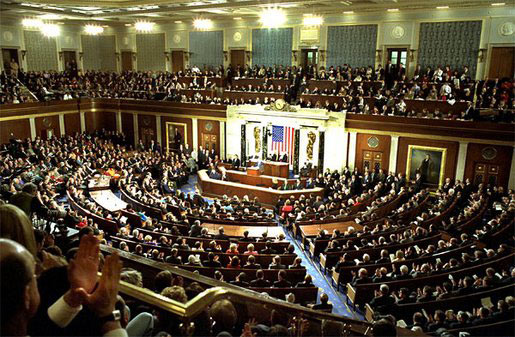
Power is frequently defined as the ability to influence the behavior of others with or without resistance.
Differentiate between power and constraint, using real life examples
- Power can be seen as evil or unjust, but the exercise of power is accepted as endemic to humans as social beings. The use of power need not involve coercion, force or the threat of force.
- The sociological examination of power concerns itself with discovering and describing the relative strengths: equal or unequal; stable or subject to periodic change.
- Power may derive from a number of sources, including social class (material wealth can equal power), resource currency (material items such as money, property, food), personal or group charisma, or social influence of tradition (compare ascribed power).
- Researchers have documented the bystander effect: they found that powerful people are three times as likely to first offer help to a stranger in distress.
- unilateralism : A tendency of nations to act on their own, or with only minimal consultation and involvement with other nations.
- bystander effect : When someone is less likely to help another if other potential helpers are present.
- power elite : a small group of people who control a disproportionate amount of wealth or political power
- power : The ability to get one’s way even in the face of opposition to one’s goals.
Power is frequently defined by political scientists as the ability to influence the behavior of others with or without resistance. The term authority is often used for power perceived as legitimate by the social structure. Power can be seen as evil or unjust, but the exercise of power is accepted as endemic to humans as social beings. The use of power need not involve coercion, force or the threat of force. At one extreme, power closely resembles what English speakers call “influence”, although some authors make a distinction between the two.
The sociological examination of power involves discovering and describing the relative strengths: equal or unequal; stable or subject to periodic change. Sociologists usually analyze relationships in which parties have relatively equal or nearly equal power in terms of constraint rather than of power. Thus power has a connotation of unilateralism. If this were not so, then all relationships could be described in terms of power, and its meaning would be lost.
Power may derive from a number of sources, including social class (material wealth can equal power), resource currency (material items such as money, property, food), personal or group charisma, ascribed power (acting on perceived or assumed abilities, whether these bear testing or not), social influence of tradition (compare ascribed power), etc.
People use more than rewards, threats and information to influence others. In everyday situations, people use a variety of power tactics to push or prompt others into particular action. There are many examples of power tactics that are quite common and employed everyday. Some of these tactics include bullying, collaboration, complaining, criticizing, demanding, disengaging, evading, humor, inspiring, manipulating, negotiating, socializing and supplicating. Recent experimental psychology suggests that the more power one has the less one takes on the perspective of others, implying that the powerful have less empathy.
Powerful people are also more likely to take action. In one example, more powerful people turned off an irritatingly close fan twice as much as less powerful people. Researchers have documented the “bystander effect” and found that powerful people are three times as likely to first offer help to a stranger in distress.
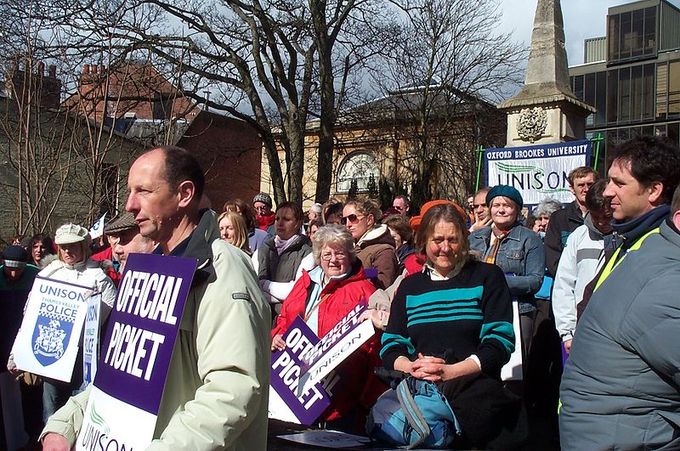
Authority refers to the use of power that is seen as legitimate or socially approved/recognized.
Give examples of the three types of authority as defined by Max Weber and what distinguishes all of them from coercion or force
- Power can be exerted by the use of force or violence. Authority, by contrast, depends on subordinate groups consenting to the use of power wielded by superior groups.
- Weber defined domination (authority) as the chance of commands being obeyed by a specifiable group of people. Legitimate authority is that which is recognized as legitimate and justified by both the ruler and the ruled.
- Weber states that legitimacy distinguishes authority, from coercion, force, power, leadership, persuasion and influence. Superiors, he states, feel that they have a right to issue commands; subordinates perceive an obligation to obey.
- Authoritarianism primarily differs from totalitarianism in that social and economic institutions exist that are not under governmental control.
- The three attributes of authority are status, specialist skills, and social position.
- authority : The power to enforce rules or give orders.
Authority is the legitimate or socially approved use of power that a person or a group holds over another. Legitimacy is vital to the notion of authority; legitimacy is the main means by which authority is distinguished from more general notions of power. Power can be exerted by the use of force or violence. Authority, by contrast, depends on subordinate groups consenting to the use of power wielded by superior groups.
Max Weber, in his sociological and philosophical work, identified and distinguished three types of legitimate domination ( Herrschaft in German, which generally means ‘domination’ or ‘rule’). These have sometimes been translated to English as types of authority, because domination is not seen as a political concept. Weber defined domination (authority) as the chance of commands being obeyed by a specifiable group of people. Legitimate authority is that which is recognized as legitimate and justified by both the ruler and the ruled.
The first type discussed by Weber is rational-legal authority. It is a form of authority with legitimacy that depends on formal rules and established laws of the state, which are usually written down and are often very complex.
The second type of authority is traditional authority, which derives from long-established customs, habits, and social structures. When power passes from one generation to another, it is known as traditional authority.
The third form of authority is charismatic authority. Here, the charisma of the individual or the leader plays an important role.
Weber states that legitimacy distinguishes authority from coercion, force, power, leadership, persuasion, and influence. Superiors, he states, feel that they have a right to issue commands; subordinates perceive an obligation to obey. The degree to which these rights and obligations are felt is based on the perceived legitimacy of the authority. A well-established, respected, democratically elected government typically wields more authority than an ad hoc, temporary, or corrupt government.

Authority and Legitimate Violence
Max Weber conceived of the state as a monopoly of the legitimate use of physical force.
Assess Weber’s argument about the state’s relationship to physical force
- Weber defines the state as a community successfully claiming authority over legitimate use of physical force in a given territory.
- Besides the police and the military, private force can be used too, as long as it has legitimacy derived from the state.
- The right of self-defense is the right by which civilians acting on their own behalf may engage in violence for the sake of defending one’s own life or the lives of others.
- right of self-defense : The right of self-defense (according to U.S. law) is the right by which civilians acting on their own behalf may engage in violence for the sake of defending one’s own life or the lives of others, including the use of deadly force.
- the state : A state is a political organization with a centralized government that maintains a monopoly over the legitimate use of force within a certain territory.
- Max Weber : (1864–1920) A German sociologist, philosopher, and political economist who profoundly influenced social theory, social research, and the discipline of sociology itself.
- monopoly : a situation in which one party or company exclusively provides a particular product or service, dominating that market and generally exerting powerful control over it
Max Weber, in Politics as a Vocation , conceived of the state as a monopoly of the legitimate use of physical force. According to Weber, the state is that entity that “upholds the claim to the monopoly of the legitimate use of physical force in the enforcement of its order. ” The state’s authority is derived from this: the state can enforce its precepts through force without losing its legitimate authority. This definition of the state has figured prominently in philosophy of law and in political philosophy throughout the twentieth century.
Ownership of territory is another characteristic that Weber deemed prerequisite for a state. Territory is necessary because it defines the scope of the state’s authority: use of force is acceptable, but only in the jurisdiction specified by the state’s lands. Such a monopoly, according to Weber, must occur via a process of legitimation.
The police and the military are the state’s main instruments of legitimate violence, but this does not mean that only public force can be used: private force can be used, too, as long as it has legitimacy derived from the state. The right of self-defense is the right by which civilians acting on their own behalf may engage in violence for the sake of defending one’s own life or the lives of others, including the use of deadly force. In any instance where an individual uses force to defend a third party, it must be demonstrated that the third party was in a position that required another individual’s intervention. The right of self-defense is a private form of legitimate violence that is recognized by the state.

Traditional Authority
Traditional authority refers to a form of leadership in which authority derives from tradition or custom.
Compare patrimonial government with feudalism within the context of traditional authority
- Weber traced traditional domination back to patriarchs, their households, and the ancient tradition of family. In such systems, the master is designated in accordance with the rules of inheritance.
- Patrimonial government occurs when the ruler’s household expands to governmental offices. All officials are personal dependents or favorites of the ruler, and are appointed by him.
- Feudalism replaced the paternal relationship of patrimonalism with a contract of allegiance based on knightly militarism.
- feudalism : A social system that is based on personal ownership of resources and personal fealty between a suzerain (lord) and a vassal (subject). Defining characteristics of feudalism are direct ownership of resources, personal loyalty, and a hierarchical social structure reinforced by religion.
- patrimonial government : A form of governance in which all power flows directly from the leader. The leaders of these countries typically enjoy absolute personal power.
- tradition : A part of culture that is passed from person to person or generation to generation, possibly differing in detail from family to family, such as the way holidays are celebrated.
Traditional authority is a type of leadership in which the authority of a ruling regime is largely tied to tradition or custom. In sociology, the concept of traditional authority comes from Max Weber ‘s tripartite classification of authority. In addition to traditional authority, Weber claimed that the other two styles of authority were charismatic authority and rational-legal authority. Weber noted that, in history, these ideal types of domination always seemed to occur in combinations.
Weber traced traditional domination back to patriarchs, their households, and the ancient tradition of the family. In such systems, the master, almost exclusively an older father, is designated in accordance with the rules of inheritance. He has no administrative staff, nor any machinery to enforce his will by force alone. Instead, he depends on the willingness of subservient group members to respect his authority. They obey him based on the belief that this is their duty, sanctioned by tradition.
Patrimonial government is related to this model, but is slightly different. This occurs when a patriarchal ruler’s household expands to governmental offices. In this style of leadership, all officials are personal dependents or favorites of the ruler, and are appointed by the ruler. Their interactions with the ruler are based on paternal authority and filial dependence. Military force is an important instrument of patrimonial rule. Patrimonial dominance has often prevailed in the Orient.
Patrimonalism and Feudalism
In comparison to patrimonalism, feudalism has one major similarity and several important differences. The similarity is that both are based on tradition and have powerful rulers who grant rights in return for military and administrative services. There are two important differences. First, feudalism replaced the paternal relationship of patrimonalism with a contract of allegiance based on knightly militarism. Second, in a patrimonial government, officials are personally dependent on the patriarch. In feudalism, these individuals are replaced with vassals, who have contractual freedom, personal allegiance, and socioeconomic prominence.
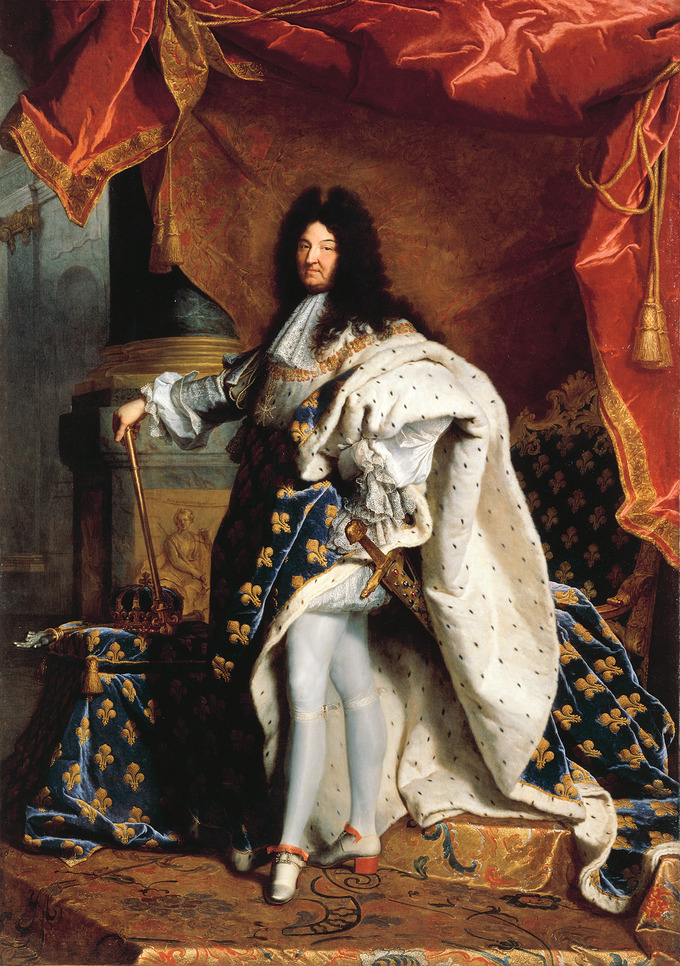
Rational-Legal Authority
Rational-legal authority is a form of leadership in which authority is largely tied to legal rationality, legal legitimacy, and bureaucracy.
Recall the three characteristics of the modern state, according to Weber
- Unlike charismatic authority and traditional authority, rational-legal authority derives its powers from the system of bureaucracy and legality.
- Weber defined legal order as a system wherein the rules are enacted and obeyed as legitimate because they are in line with other laws on how they can be enacted and how they should be obeyed.
- The modern state based on rational-legal authority emerged from the patrimonial and feudal struggle for power uniquely in Western civilization.
- A modern state exists where a political community has created an administrative and legal order, binding authority over citizens, and the legitimate use of physical force.
- legal order : A system where the rules are enacted and obeyed as legitimate because they are in line with other laws on how they can be enacted and how they should be obeyed. Further, they are enforced by a government that monopolizes their enactment and the legitimate use of physical force.
- bureaucracy : Structure and regulations in place to control activity. Usually in large organizations and government operations.

Rational-legal authority is a form of leadership in which the authority of an organization or a ruling regime is largely tied to legal rationality, legal legitimacy, and bureaucracy. It is the second of Max Weber ‘s tripartite classification of authority. The majority of the modern states of the twentieth century are rational-legal authorities, according to those who use this form of classification.
Unlike charismatic authority and traditional authority, rational-legal authority derives its powers from the system of bureaucracy and legality. Weber defined legal order as a system wherein the rules are enacted and obeyed as legitimate because they are in line with other laws on how they can be enacted and how they should be obeyed. These rules are enforced by a government that monopolizes their enactment, while holding the legitimate use of physical force.
Weber wrote that the modern state based on rational-legal authority emerged from the patrimonial and feudal struggle for power uniquely in Western civilization. The prerequisites for the modern Western state are the monopoly by a central authority of the means of administration and control; the monopoly of legislative authority; and the organization of officialdom, dependent upon the central authority.
According to Max Weber, a modern state exists where a political community has three elements. First, an administrative and legal order that has been created and can be changed by legislation that also determines its role. Second, it must have binding authority over citizens and actions in its jurisdiction. Lastly, it must possess the right to legitimately use the physical force in its jurisdiction.

Charismatic Authority
Charismatic authority is power legitimized by a leader’s exceptional personal qualities, which inspire loyalty and obedience from followers.
Create a model of a hypothetical charismatic leader in a hypothetical government which describes the charisma and explains in detail how it is legitimized, used, and maintained
- For Weber, charisma applies to “a certain quality of an individual personality, by virtue of which he is set apart from ordinary men and treated as endowed with supernatural powers “.
- In contrast to the current popular use of the term charismatic leader, Weber saw charismatic authority not so much as character traits of the charismatic leader, but as a relationship between the leader and his followers.
- A cult of personality refers to when an individual uses mass media, propaganda, or other methods to create an idealized and heroic public image, often through unquestioning flattery and praise.
- The methods of charismatic succession are search, revelation, designation by original leader, designation by qualified staff, hereditary charisma, and office charisma.
- routinization : Charismatic authority almost always endangers the boundaries set by traditional or rational (legal) authority. It tends to challenge this authority, and is thus often seen as revolutionary. Usually this charismatic authority is incorporated into society. Hereby the challenge that it presents to society will subside. The way in which this happens is called routinization.
- cult of personality : A situation where a leader (often a dictator) has been falsely idolized and made into a national or group icon and is revered as a result.
- revelation : A manifestation of divine truth.
Charismatic authority is one of three forms of authority laid out in Max Weber’s tripartite classification of authority. Weber defined charismatic authority as “resting on devotion to the exceptional sanctity, heroism or exemplary character of an individual person, and of the normative patterns or order revealed or ordained by him”.

Charismatic authority is power legitimized on the basis of a leader’s exceptional personal qualities, or the demonstration of extraordinary insight and accomplishment, which inspire loyalty and obedience from followers. In contrast to the current popular use of the term charismatic leader, Weber saw charismatic authority not so much as character traits of the charismatic leader but as a relationship between the leader and his followers. For Weber, charisma applies to “a certain quality of an individual personality, by virtue of which he is set apart from ordinary men and treated as endowed with supernatural, superhuman, or at least specifically exceptional powers or qualities. ”
Charismatic authority almost always evolves in the context of boundaries set by traditional or rational-legal authority, but by its nature tends to challenge this authority, and is thus often seen as revolutionary. However, the constant challenge that charismatic authority presents to a particular society will eventually subside as it is incorporated into that society through routinization. Routinization is the process by which “charismatic authority is succeeded by a bureaucracy controlled by a rationally established authority or by a combination of traditional and bureaucratic authority. ”
In politics, charismatic rule is often found in various authoritarian states, autocracies, dictatorships, and theocracies. In order to help to maintain their charismatic authority, such regimes will often establish a vast cult of personality, which is signaled when an individual uses mass media, propaganda, or other methods to create an idealized and heroic public image, often through unquestioning flattery and praise. When the leader of such a state dies or leaves office and a new charismatic leader does not appear, such a regime is likely to fall shortly thereafter unless it has become fully routinized.

According to Max Weber, the methods of charismatic succession are search, revelation, designation by original leader, designation by qualified staff, hereditary charisma, and office charisma. These are the various ways in which an individual and a society can contrive to maintain the unique energy and nature of charisma in their leadership.

The Transfer of Authority
In the United States, transfers of authority generally occur after presidential elections.
Compare presidential transitions with transitional justice using real-life examples
- A presidential transition refers to the period of time between the end of a presidential election and the inauguration of a new president.
- In the United States, during a presidential transition, the outgoing, “lame duck” president has lost many of the intangible benefits of a presidency, but the incoming president-elect is not yet legally empowered to enforce policy.
- Transitional justice refers to a range of efforts, on the part of the state, to address past human rights violations. These efforts include both judicial and non-judicial methods.
- In the context of transitional justice, memorialization is used to honor the victims of human rights abuses.
- president-elect : a person who has been elected to a presidency but has not yet been inducted into office
- transitional justice : Transitional justice generally refers to a range of approaches that states may use to address past human rights violations. This includes both judicial and non-judicial approaches.
- Presidential transition : A presidential transition or presidential interregnum refers to the period of time between the end of a presidential election and the inauguration of a new president.
Presidential Transitions
A presidential transition refers to the period of time between the end of a presidential election and the inauguration of a new president. During this time, the incoming president usually designates new governmental personnel, including those individuals who will either serve in the cabinet or lead governmental agencies.
In the United States, the presidential transition extends from the date of the presidential election, in early November, until the twentieth day of January in the following year. This was specified in the Twentieth Amendment to the Constitution. During a presidential transition, the outgoing president, also known as the “lame duck,” has lost many of the intangible benefits of a presidency. That being said, the incoming president-elect is not yet legally empowered to enforce policy. This ambiguity, between the president-elect and outgoing president, creates the potential for a leadership vacuum, which may be most acutely felt during wartime or times of economic crisis.
Transitional Justice
In other nations, many of which have experienced undemocratic governments and dictators, transitional justice refers to a state’s efforts to address past human rights violations. These efforts can be both judicial and non-judicial, and refer to actions, policies or institutions that are enacted at a point of political transition from violence or repression to societal stability. As a project, transitional justice has a number of goals, including rebuilding social trust, repairing a fractured judicial system, and building a democratic system of governance.
In the context of transitional justice, memorialization is used to honor the victims of human rights abuses. By demonstrating respect and acknowledging the past, national memorials can help governments reconcile tensions with victims. They can also help to establish a record of history and to prevent the recurrence of abuse.
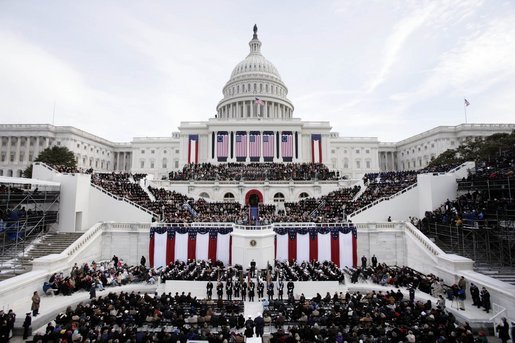
Contributors and Attributions
- Curation and Revision. by : Boundless.com. CC BY-SA
Home — Essay Samples — Government & Politics — Political Culture — Power, Legitimacy & Authority: Key Concepts in Understanding Politics
Power, Legitimacy & Authority: Key Concepts in Understanding Politics
- Categories: Political Culture Political Participation
About this sample

Words: 2500 |
13 min read
Published: May 17, 2022
Words: 2500 | Pages: 5 | 13 min read
Table of contents
Introduction, bibliography.
Nearly all men can stand adversity, but if you want to test a man’s character give him power. Say no to plagiarism. Get a tailor-made essay on 'Why Violent Video Games Shouldn't Be Banned'? Get original essay - Abraham Lincoln
State of nature
Government formation, political issues, personal loyalty, my changing perspective.
- Beethnam, D., 2001. Political Legitmacy. pp. 107-116.
- Farell, L. O., 2019. Thomas Hobbs on the State on Nature , s.l.: s.n.
- Fieser, J. & Dowden, B., 1995. Internet enclyopedia of philophy; a Peer academic resorce. [Online]
- Available at: https://www.iep.utm.edu/
- [Accessed 2019 2019].
- Jacob Weisberg , 2008. Loyalty; It’s the most overrated virtue in politics.. [Online]
- Available at: https://slate.com/news-and-politics/2008/11/loyalty-is-the-most-overrated-virtue-in-politics.html
- Miller, D., 2003. Political Philosophy; A short intorduction. oxford : oxford press .
- Politics, 2002. Andrew heywood. 2nd ed. New York : Palgrave Macmillan.
- Robinson, N., 2019. Justifying power: the legitimation of authority, s.l.: s.n.

Cite this Essay
Let us write you an essay from scratch
- 450+ experts on 30 subjects ready to help
- Custom essay delivered in as few as 3 hours
Get high-quality help

Verified writer
- Expert in: Government & Politics

+ 120 experts online
By clicking “Check Writers’ Offers”, you agree to our terms of service and privacy policy . We’ll occasionally send you promo and account related email
No need to pay just yet!
Related Essays
1 pages / 572 words
7 pages / 3092 words
2 pages / 989 words
2 pages / 928 words
Remember! This is just a sample.
You can get your custom paper by one of our expert writers.
121 writers online
Still can’t find what you need?
Browse our vast selection of original essay samples, each expertly formatted and styled
Related Essays on Political Culture
ABC News. (2011). Twitter: The Political Sex Scandal Response Tool of the 21st Century. Retrieved from [...]
Logical fallacies are errors in reasoning that can undermine the validity of an argument. In the context of politics, the use of logical fallacies can have significant implications for public opinion and decision-making. This [...]
In his book, Thank You for Arguing, Jay Heinrichs explores the use of rhetoric in everyday communication. The book is a comprehensive guide to persuasive language and argues that anyone can improve their ability to argue [...]
According to Max Weber (1968), legitimacy is power in which its acquisition and exercise conforms to established law, power which interprets legal rules and is rational. As such it emphasizes rule of law, constitutionalism and [...]
Kenya is a multi-ethnic society with currently forty four tribes, the Makonde people and the Hindu having been recognized as ethnic communities. The most dominant tribes being the Agikuyu, Kalenjin, Abagusii, Akamba, Abaluhya [...]
Political ideology can be defined as a set of rules, regulations, values or beliefs held by an individual or group of individuals in particular that define or establish norms rather than how society behaves and provides [...]
Related Topics
By clicking “Send”, you agree to our Terms of service and Privacy statement . We will occasionally send you account related emails.
Where do you want us to send this sample?
By clicking “Continue”, you agree to our terms of service and privacy policy.
Be careful. This essay is not unique
This essay was donated by a student and is likely to have been used and submitted before
Download this Sample
Free samples may contain mistakes and not unique parts
Sorry, we could not paraphrase this essay. Our professional writers can rewrite it and get you a unique paper.
Please check your inbox.
We can write you a custom essay that will follow your exact instructions and meet the deadlines. Let's fix your grades together!
Get Your Personalized Essay in 3 Hours or Less!
We use cookies to personalyze your web-site experience. By continuing we’ll assume you board with our cookie policy .
- Instructions Followed To The Letter
- Deadlines Met At Every Stage
- Unique And Plagiarism Free
Power, Authority & Legitimacy Theory
- All politics is about power – achieving and maintaining it – Hobbes – basic human urge is to seek ‘power after power’. Programmed – Dawkins’ selfish gene. Conservative viewpoint.
- The ability to get someone to do something they otherwise wouldn’t do – ‘power to’.
- Distinguished with authority by power being the ability to do and authority right to do.
- Distinction from influence – ability to affect outcome even if not having actual final power to decide – influence is a minor form of power by affecting their actions without inciting force/fear – e.g. manipulation.
- Lukes sees power in three forms: decision-making, agenda setting and thought control.
- Decision-making – associated with liberal and pluralist perceptions focussing on who actually makes the decisions. Boulding argues decision-making influenced in three ways: the stick (coercion), the deal (mutual benefit through negotiation), and the kiss (sense of loyalty and commitment to individual, thus he has power).
- Dahl observed decision-making ‘Critique of the ruling elite model’ and found no single elite in charge, pluralist approach, everyone has a say. Different groups have a say on different aspects. Reality was an “example of a democratic system warts and all”.
- Elitist critiques argue this fails to understand unequal influence of key elites – real decisions made by a fixed elite – real power belongs to banks and military C.Wright Mills .
- Hobbes – physical or mechanical power whereby power is used against an individual’s will – individual is subservient to it, otherwise life would be nasty, brutish and short. Advocates strong, monarchical government.
- Agenda setting – Bachrach Baratz –idea of non-decision making. Schattschneider “some issues are organised into politics and others are organised out”.
- Links to influential parties who collectively agree or just block discussion – slight elitist theory.
- B and B and ‘mobilisation of bias’ yet individuals and pressure groups can change agendas, yet more likely to do so on issues represented by well informed and articulate. Elite tend to dominate flow of information and media and so use this to their advantage. Look at the way demonstrations are portrayed in the media.
- Marxists would argue agenda setting is a facade for bourgeois dominance with parliamentary systems of government being “the executive committee of the bourgeoisie” (Marx).
- Thought control – previous two assume that people and groups are rational and capable of knowing their own mind. The ability to manipulate human behaviour can be shaped – some argue this is where the real power lies.
- Marxist ideas based on favouritism of state towards bourgeoisie and their power through economy and politics – Gramsci and bourgeois hegemony – bourgeoisie literally control popular culture and so control the way we think. Therefore we think life is only better with material goods so bourgeoisie benefit even more.
- Vance Packard – consumer based society and only think we’re happy when we have material goods.
- New Left ideas and Marcuse – link to totalitarianism but with media, TUs, adverts, culture replacing brutal coercion manipulating needs.
- Difference between ‘real’ and ‘felt’ interests – Engels and false consciousness. Don’t know what is in our real interest – no longer rational.
- Liberals reject this – individuals are rational.
- Generally distinguished from power through the means by which compliance and obedience are achieved – Heywood “authority is power cloaked in legitimacy”. Authority a form of rightful power.
- Authority based on a perceived ‘right to rule’ ( Weber ) with a moral aspect.
- Weber linked authority to legitimacy – different approach from others stating that legitimacy gave power authority.
- Weber – authority is important irrespective of how it’s achieved. As long as there is the perception that authority is legitimate it’s fine.
- Authority seldom exercised in absence of power.
- Weber – traditional (respect for elders), charismatic (value opinions and words through their responsibility), legal-rational (respect for right of state – parliament’s legal rights to pass new laws).
- Traditional – sanctified by history and based upon ‘immemorial custom’. Hierarchy – Burke – ‘wisdom of the ancients’. Patriarchalism – links to hereditary systems. Less relevant today, although evident in one form in theocratic states – the resurgence of this type of authority can be seen as a response to the failure of other types in degenerative Western capitalism.
- Charismatic – based entirely upon the power of an individual’s personality. Owes nothing to status, social position or office, yet can be used to promote the interests of society ( Rousseau and Law Giver).
- Charismatic has an almost messianic quality – treated with suspicion – Talmon and criticism of Rousseau.
- Legal-rational – situation for most liberal democratic Western capitalist societies. Operates through a body of clearly defined rules – linked to formal powers of office not office holder. Less likely to be abused than other 2 as the limit of authority is defined.
- Arises out of a respect for the rule of law and is evident in the constitutional framework of long-established states. Can be seen as de-personalising as there can be a relentless spread of bureaucracy e.g. civil service.
- De jure authority – authority in law. Authority from an office. Operates according to a set of rules. Closely linked to traditional/legal-rational. Related to being IN authority.
- De facto – authority in practice. Closely linked to charismatic. Authority by virtue of who they are – being AN authority.
Relationship between power and authority
- Authority is the legitimate exercise of power but debate as to whether this requires morality or PERCEPTION or rightfulness.
- Ruling by power alone eventually lead to unsustainable use of coercive resources – Mao – “all power stems from the barrel of a gun” and is the antithesis of authority.
- Can authority exist without power? Weberian sense of traditional and charismatic forms all exert influence without the need to persuade. Legal-rational based on office and power invested in the office thus need power. Also being ‘an authority’ doesn’t need recourse to power but can have influence.
Different views of authority
- Liberals – authority instrumental, coming from below through the consent of the governed – social contract.
- Do not want too much state involvement therefore authority is limited, rational and purposeful leading to preference for legal-rational.
- Conservatives – comes from above from those with experience and wisdom. Benefits other but there are few limits leading to authoritarianism through charismatic.
- Authority – justified? Essential for maintenance of order. Enemy of freedom – Libertarian/Anarchist view. Marxists – authority manufactured to mask rule by the bourgeoisie. Expectation to give unquestioning obedience is wrong as it threatens reason – Mill – intellectual diversity.
- To be in a position to exercise authority. Links to power and authority by transforming the former into the latter – turns naked power into authority.
- Moral right to rule – Locke and consent – social contrast theory – we consent to be governed. If there is a formal constitutional basis, we can see legitimacy.
- Hobbes – social contract – dictatorship could have legitimacy as it is meant to protect the individual – the Leviathan state – legitimacy comes about by preventing people getting harmed – implied consent.
- For Rousseau the state is legitimate if it upholds the general will.
- Likes of Weber see a belief in legitimacy as important no matter how it is achieved.
How do governments gain and maintain legitimacy?
- Social contract – tacit and formal agreement whereby state’s legitimacy is based on protection of citizens ( Hobbes ) and promotion of rights and freedoms ( Locke ) and the common good ( Rousseau ).
- Locke challenged Hobbes as he believed a man could not give away more power over himself than he himself has. Tacit consent is given to the government by anyone who has “possession or enjoyment of any part of the dominions of any government”.
- Popular compliance – populace have a belief in the right to rule which in a democracy is based around the exercise of legal-rational authority.
- Constitutionalism – Beetham – legitimacy operating under existing established principles thus power exercised through the existing constitutional process if this adheres to the widely held beliefs and values of a society.
- 1. Power exercised according to certain rules.
- 2. Rules justified in terms of ruler and ruled – marrying the shared belief between government and people (communitarianism).
- 3. People must give consent – how much consent must people give to give something legitimacy?
- Active consent – seen through ballot box with a mandate given to exercise legitimacy – elections/referendums and strengthened by universal suffrage – Mill .
- Legitimation crisis – neo-Marxist Habermas – legitimacy of a political system could collapsed because of the pressures created by democracy and capitalism. Democracy – voting becomes a means of consumerism. Capitalism – increased desire leads to recession – can’t continually provide what people want – e.g. extensive welfare provision. Legitimation crisis created after government intervention and conflict of free-market.
- Social contract – Giddens – communitarianism – Etzioni – taking social contract and trying to improve civic engagement through modern political systems.
- Ideological Hegemony – Conventional image of liberal democracies is that they enjoy legitimacy because they respect individual liberty and are responsive to public opinion. Critics – democracy is little more than a facade concealing the domination of a “power elite”.
- Ralph Milliband – liberal democracy is “capitalist democracy” – there are biases which serve interests of private property and ensure the long term stability of capitalism.
- Marxists state that bourgeois ideology denotes sets of ideas which conceal the contradictions upon which class societies are based – ideology propagates falsehood, delusion and mystification. Ideology operates in interests of the ruling class.
- Modern Marxists – political competition does exist but this competition is unequal. Gramsci drew attention to the degree to which the class system was upheld not simply by unequal power but also what he called bourgeois hegemony.
Legitimacy in a dictatorship
- Weber argues that traditional and charismatic authority can be legitimate if accepted by populace. Marx argued that a dictatorship of the proletariat would be legitimate as it was acting in the best interests of the masses; likewise dictators claim to uphold common good without popular approval. Traditional monarchs also claimed to be adhering to divine right as the best form of determining the common good.


Want to create or adapt books like this? Learn more about how Pressbooks supports open publishing practices.
14.1 Power and Authority
Learning objectives.
- Define power and the three types of authority.
- List Weber’s three types of authority.
- Explain why charismatic authority may be unstable in the long run.
Politics refers to the distribution and exercise of power within a society, and polity refers to the political institution through which power is distributed and exercised. In any society, decisions must be made regarding the allocation of resources and other matters. Except perhaps in the simplest societies, specific people and often specific organizations make these decisions. Depending on the society, they sometimes make these decisions solely to benefit themselves and other times make these decisions to benefit the society as a whole. Regardless of who benefits, a central point is this: some individuals and groups have more power than others. Because power is so essential to an understanding of politics, we begin our discussion of politics with a discussion of power.
Power refers to the ability to have one’s will carried out despite the resistance of others. Most of us have seen a striking example of raw power when we are driving a car and see a police car in our rearview mirror. At that particular moment, the driver of that car has enormous power over us. We make sure we strictly obey the speed limit and all other driving rules. If, alas, the police car’s lights are flashing, we stop the car, as otherwise we may be in for even bigger trouble. When the officer approaches our car, we ordinarily try to be as polite as possible and pray we do not get a ticket. When you were 16 and your parents told you to be home by midnight or else, your arrival home by this curfew again illustrated the use of power, in this case parental power. If a child in middle school gives her lunch to a bully who threatens her, that again is an example of the use of power, or, in this case, the misuse of power.
These are all vivid examples of power, but the power that social scientists study is both grander and, often, more invisible (Wrong, 1996). Much of it occurs behind the scenes, and scholars continue to debate who is wielding it and for whose benefit they wield it. Many years ago Max Weber (1921/1978), one of the founders of sociology discussed in earlier chapters, distinguished legitimate authority as a special type of power. Legitimate authority (sometimes just called authority ), Weber said, is power whose use is considered just and appropriate by those over whom the power is exercised. In short, if a society approves of the exercise of power in a particular way, then that power is also legitimate authority. The example of the police car in our rearview mirrors is an example of legitimate authority.
Weber’s keen insight lay in distinguishing different types of legitimate authority that characterize different types of societies, especially as they evolve from simple to more complex societies. He called these three types traditional authority, rational-legal authority, and charismatic authority. We turn to these now.
Traditional Authority
As the name implies, traditional authority is power that is rooted in traditional, or long-standing, beliefs and practices of a society. It exists and is assigned to particular individuals because of that society’s customs and traditions. Individuals enjoy traditional authority for at least one of two reasons. The first is inheritance, as certain individuals are granted traditional authority because they are the children or other relatives of people who already exercise traditional authority. The second reason individuals enjoy traditional authority is more religious: their societies believe they are anointed by God or the gods, depending on the society’s religious beliefs, to lead their society. Traditional authority is common in many preindustrial societies, where tradition and custom are so important, but also in more modern monarchies (discussed shortly), where a king, queen, or prince enjoys power because she or he comes from a royal family.
Traditional authority is granted to individuals regardless of their qualifications. They do not have to possess any special skills to receive and wield their authority, as their claim to it is based solely on their bloodline or supposed divine designation. An individual granted traditional authority can be intelligent or stupid, fair or arbitrary, and exciting or boring but receives the authority just the same because of custom and tradition. As not all individuals granted traditional authority are particularly well qualified to use it, societies governed by traditional authority sometimes find that individuals bestowed it are not always up to the job.
Rational-Legal Authority
If traditional authority derives from custom and tradition, rational-legal authority derives from law and is based on a belief in the legitimacy of a society’s laws and rules and in the right of leaders to act under these rules to make decisions and set policy. This form of authority is a hallmark of modern democracies, where power is given to people elected by voters, and the rules for wielding that power are usually set forth in a constitution, a charter, or another written document. Whereas traditional authority resides in an individual because of inheritance or divine designation, rational-legal authority resides in the office that an individual fills, not in the individual per se. The authority of the president of the United States thus resides in the office of the presidency, not in the individual who happens to be president. When that individual leaves office, authority transfers to the next president. This transfer is usually smooth and stable, and one of the marvels of democracy is that officeholders are replaced in elections without revolutions having to be necessary. We might not have voted for the person who wins the presidency, but we accept that person’s authority as our president when he (so far it has always been a “he”) assumes office.
Rational-legal authority helps ensure an orderly transfer of power in a time of crisis. When John F. Kennedy was assassinated in 1963, Vice President Lyndon Johnson was immediately sworn in as the next president. When Richard Nixon resigned his office in disgrace in 1974 because of his involvement in the Watergate scandal, Vice President Gerald Ford (who himself had become vice president after Spiro Agnew resigned because of financial corruption) became president. Because the U.S. Constitution provided for the transfer of power when the presidency was vacant, and because U.S. leaders and members of the public accept the authority of the Constitution on these and so many other matters, the transfer of power in 1963 and 1974 was smooth and orderly.
Charismatic Authority
Charismatic authority stems from an individual’s extraordinary personal qualities and from that individual’s hold over followers because of these qualities. Such charismatic individuals may exercise authority over a whole society or only a specific group within a larger society. They can exercise authority for good and for bad, as this brief list of charismatic leaders indicates: Joan of Arc, Adolf Hitler, Mahatma Gandhi, Martin Luther King Jr., Jesus Christ, Muhammad, and Buddha. Each of these individuals had extraordinary personal qualities that led their followers to admire them and to follow their orders or requests for action.
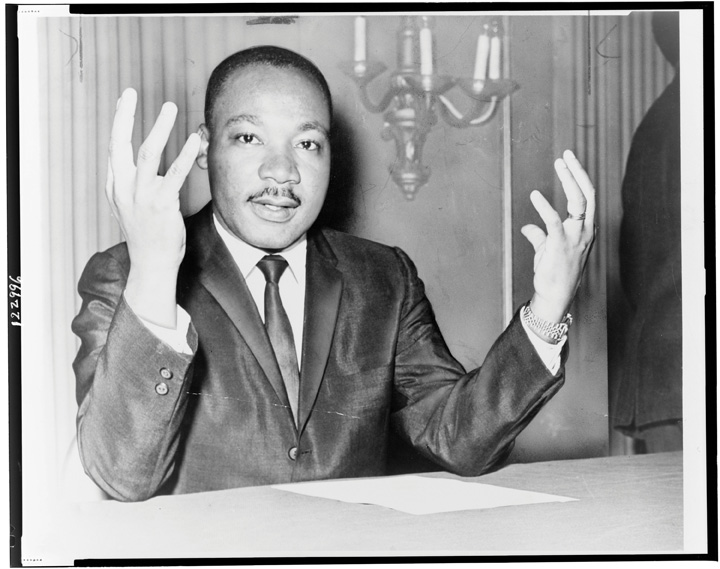
Much of Dr. Martin Luther King Jr.’s appeal as a civil rights leader stemmed from his extraordinary speaking skills and other personal qualities that accounted for his charismatic authority.
U.S. Library of Congress – public domain.
Charismatic authority can reside in a person who came to a position of leadership because of traditional or rational-legal authority. Over the centuries, several kings and queens of England and other European nations were charismatic individuals as well (while some were far from charismatic). A few U.S. presidents—Washington, Lincoln, both Roosevelts, Kennedy, Reagan, and, for all his faults, even Clinton—also were charismatic, and much of their popularity stemmed from various personal qualities that attracted the public and sometimes even the press. Ronald Reagan, for example, was often called “the Teflon president,” because he was so loved by much of the public that accusations of ineptitude or malfeasance did not stick to him (Lanoue, 1988).
Weber emphasized that charismatic authority in its pure form (i.e., when authority resides in someone solely because of the person’s charisma and not because the person also has traditional or rational-legal authority) is less stable than traditional authority or rational-legal authority. The reason for this is simple: once charismatic leaders die, their authority dies as well. Although a charismatic leader’s example may continue to inspire people long after the leader dies, it is difficult for another leader to come along and command people’s devotion as intensely. After the deaths of all the charismatic leaders named in the preceding paragraph, no one came close to replacing them in the hearts and minds of their followers.
Because charismatic leaders recognize that their eventual death may well undermine the nation or cause they represent, they often designate a replacement leader, who they hope will also have charismatic qualities. This new leader may be a grown child of the charismatic leader or someone else the leader knows and trusts. The danger, of course, is that any new leaders will lack sufficient charisma to have their authority accepted by the followers of the original charismatic leader. For this reason, Weber recognized that charismatic authority ultimately becomes more stable when it is evolves into traditional or rational-legal authority. Transformation into traditional authority can happen when charismatic leaders’ authority becomes accepted as residing in their bloodlines, so that their authority passes to their children and then to their grandchildren. Transformation into rational-legal authority occurs when a society ruled by a charismatic leader develops the rules and bureaucratic structures that we associate with a government. Weber used the term routinization of charisma to refer to the transformation of charismatic authority in either of these ways.
Key Takeaways
- Power refers to the ability to have one’s will carried out despite the resistance of others.
- According to Max Weber, the three types of legitimate authority are traditional, rational-legal, and charismatic.
- Charismatic authority is relatively unstable because the authority held by a charismatic leader may not easily extend to anyone else after the leader dies.
For Your Review
- Think of someone, either a person you have known or a national or historical figure, whom you regard as a charismatic leader. What is it about this person that makes her or him charismatic?
- Why is rational-legal authority generally more stable than charismatic authority?
Lanoue, D. J. (1988). From Camelot to the teflon president: Economics and presidential popularaity since 1960. New York, NY: Greenwood Press.
Weber, M. (1978). Economy and society: An outline of interpretive sociology (G. Roth & C. Wittich, Eds.). Berkeley: University of California Press. (Original work published 1921).
Wrong, D. H. (1996). Power: Its forms, bases, and uses . New Brunswick, NJ: Transaction.
Sociology Copyright © 2016 by University of Minnesota is licensed under a Creative Commons Attribution-NonCommercial-ShareAlike 4.0 International License , except where otherwise noted.
Understanding Legitimacy in Weber’s Perspectives and in Contemporary Society
- First Online: 20 April 2022
Cite this chapter
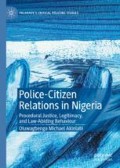
- Oluwagbenga Michael Akinlabi 4
Part of the book series: Palgrave's Critical Policing Studies ((PCPS))
259 Accesses
Modern thinking about legitimacy has been greatly influenced by Max Weber. According to Weber, people in authority often concoct ‘myths’ about their superiority or natural fitness to be in a position of power. These mythical justifications or claims are often necessary in order to claim moral justifications for their authority and sense of political propriety. These claims come in three broad forms: traditional, charismatic, and legal-rational dominations. They are often referred to as the ‘three inner justifications’ or the ‘basic legitimations of the power holder’. Succinctly put, traditional claims for legitimacy rest on grounds such as: ‘obey me because this is what our people have always done’; charismatic commands such as ‘obey me because I can transform your life’; and lastly, legal-rational orders like ‘obey me because I am your lawfully appointed superior’. These three basic legitimations of power holders and their relevance to modern society, especially their applicability to the African context, is discussed in this chapter.
This is a preview of subscription content, log in via an institution to check access.
Access this chapter
- Available as PDF
- Read on any device
- Instant download
- Own it forever
- Available as EPUB and PDF
- Compact, lightweight edition
- Dispatched in 3 to 5 business days
- Free shipping worldwide - see info
- Durable hardcover edition
Tax calculation will be finalised at checkout
Purchases are for personal use only
Institutional subscriptions
Ajayi, A. T., & Buhari, L. O. (2014). Methods of Conflict Resolution in African Traditional Society. African Research Review, 8 (2), 138–157.
Article Google Scholar
Baker, B. (2010). Security in Post-Conflict Africa: The Role of Nonstate Policing . CRC Press.
Google Scholar
Balandier, G. (1972). Political Anthropology . Pantheon Books.
Bendix, R. (1966). Max Weber: An Intellectual Portrait . Methuen.
Berger, P. L. (1973). The Social Reality of Religion . Penguin.
Berger, P. L. (2011). The Sacred Canopy: Elements of a Sociological Theory of Religion . Open Road Integrated Media.
Blau, P. M. (1963). Critical Remarks on Weber’s Theory of Authority. The American Political Science Review, 57 (2), 305–316.
Cotterrell, R. (1997). Legality and Legitimacy: The Sociology of Max Weber. Oxford Scholarship Online, Mar-12 . https://doi.org/10.1093/acprof:oso/9780198264903.003.0007
Dogan, M. (2003). Conceptions of Legitimacy. In M. Hawkesworth & M. Kogan (Eds.), Encyclopedia of Government and Politics (Vol. 2, pp. 116–219). Routledge.
Gerth, H. H., & Mills, C. W. (2007). From Max Weber: Essays in Sociology . Routledge.
Gilley, B. (2006). The Meaning and Measure of State Legitimacy: Results for 72 Countries. European Journal of Political Research, 45 (3), 499–525.
Grandin, G. (2013, March 5). On the Legacy of Hugo Chávez. The Nation . http://www.thenation.com/article/173212/legacy-hugo-chavez#axzz2Z5agTpJL
Isiramen, C. O. (2005). The African Traditional Religion’s Business Ethics: A Paradigm for Spirituality in the Global Ethical Standard. In N. Capaldi (Ed.), Business and Religion: A Clash of Civilizations? (pp. 390–397). M & M Scrivener Press.
Jackson, J., Tyler, T. R., Bradford, B., Taylor, D., & Shiner, M. (2010). Legitimacy and Procedural Justice in Prisons. Prison Service Journal, 191 , 4–10.
Martin, R. (1977). The Sociology of Power . Routledge & Kegan Paul.
Matheson, C. (1987). Weber and the Classification of Forms of Legitimacy. British Journal of Sociology, 38 , 199–215.
Mawby, R. C. (2002). Policing Images: Policing, Communication and Legitimacy . Willan.
Moore, B. (1978). Injustice: The Social Bases of Obedience and Revolt . M.E. Sharpe.
Book Google Scholar
Murphy, K. (2009). Public Satisfaction with Police: The Importance of Procedural Justice and Police Performance in Police-Citizen Encounters. The Australian and New Zealand Journal of Criminology, 42 (2), 159–178. https://doi.org/10.1375/acri.42.2.159
Musonda, A. M. (2006). Political Legitimacy: The Quest for the Moral Authority of the State, A Philosophical Analysis . Doctoral Dissertation, University of Munich. Munich, Germany. edoc.ub.uni-muenchen.de/5813/1/Musonda_Anthony.pdf
Onadeko, T. (2008). Yoruba Traditional Adjudicatory Systems. African Study Monographs, 29 (1), 15–28.
Parkin, F. (2002). Max Weber (Rev. ed.). Routledge.
Sjoberg, G. (1960). The Pre-Industrial City: Past and Present . Free Press.
Smith, S. B. (1991). Hegel’s Critique of Liberalism: Rights in Context (2nd ed.). University of Chicago Press.
Sunshine, J., & Tyler, T. R. (2003). The Role of Procedural Justice and Legitimacy in Shaping Public Support for Policing. Law & Society Review, 37 (3), 513–548. https://doi.org/10.1111/1540-5893.3703002
Tade, O., & Olaitan, F. (2015). Traditional Structures of Crime Control in Lagos, Nigeria. African Security Review, 24 (2), 138–152.
Tankebe, J. (2009). Public Cooperation with the Police in Ghana: Does Procedural Fairness Matter? Journal of Criminology, 47 , 1265–1293.
Thompson, E. P. (1975). Whigs and Hunters: The Origin of the Black Act . Allen Lane.
Tyler, T. R. (1990). Why People Obey the Law . Yale University Press.
Tyler, T. R. (2006). Why People Obey the Law . Princeton University Press.
Weber, M. (1947). The Theory of Economic and Social Organization (A. M. Henderson & T. Parsons, Trans.). The Free Press.
Weber, M. (1958). From Max Weber: Essays in Sociology . Oxford University Press.
Weber, M. (1964). The Theory of Social and Economic Organization (A. M. Henderson & T. Parsons, Trans.). The Free Press.
Weber, M. (1968). Economy and Society: An Outline of Interpretive Sociology . Bedminster Press.
Williams, D. (2003, December 2). Max Weber: Traditional, Legal-Rational, and Charismatic Authority .
Download references
Author information
Authors and affiliations.
Department of Social Sciences, Northumbria University, Newcastle upon Tyne, UK
Oluwagbenga Michael Akinlabi
You can also search for this author in PubMed Google Scholar
Corresponding author
Correspondence to Oluwagbenga Michael Akinlabi .
Rights and permissions
Reprints and permissions
Copyright information
© 2022 The Author(s), under exclusive license to Springer Nature Switzerland AG
About this chapter
Akinlabi, O.M. (2022). Understanding Legitimacy in Weber’s Perspectives and in Contemporary Society. In: Police-Citizen Relations in Nigeria. Palgrave's Critical Policing Studies. Palgrave Macmillan, Cham. https://doi.org/10.1007/978-3-030-92919-0_2
Download citation
DOI : https://doi.org/10.1007/978-3-030-92919-0_2
Published : 20 April 2022
Publisher Name : Palgrave Macmillan, Cham
Print ISBN : 978-3-030-92918-3
Online ISBN : 978-3-030-92919-0
eBook Packages : Law and Criminology Law and Criminology (R0)
Share this chapter
Anyone you share the following link with will be able to read this content:
Sorry, a shareable link is not currently available for this article.
Provided by the Springer Nature SharedIt content-sharing initiative
- Publish with us
Policies and ethics
- Find a journal
- Track your research
Academia.edu no longer supports Internet Explorer.
To browse Academia.edu and the wider internet faster and more securely, please take a few seconds to upgrade your browser .
Enter the email address you signed up with and we'll email you a reset link.
- We're Hiring!
- Help Center


Power, Authourity and Legitimacy; the similarities and Disperities

Related Papers
Somtuaka Kombian
Adrian Leftwich argues basically for the centrality and primacy of politics, and of political processes, in shaping state goals, capacity, and developmental outcomes.He believes that surmounting developmental obstacles is basically a matter of politics. The main aim of politics for him is to “identify, nurture, encourage and support those social and political forces which are necessary for forming the kind of growth coalition which will demand, design and implement the institutional arrangements which will deliver pro-poor growth and social provision” (Leftwich: 2008: 3). In this way, development becomes quintessentially political according to Leftwich. This kind of politics is healthy and can propel development in Ghana. But what is the greatest threat to this sort of politics? This research answers that it is patrimonialism. Weber defined patrimonialism as a pre-bureaucratic type of domination “based not on the official’s commitment to an impersonal purpose and not on obedience to abstract norms, but on a strictly personal loyalty” (Weber: 1978: 1006). The basic argument in this research is that, patrimonialism is a very poor socio-political arrangement which woefully fails to infuse in the citizenry the genuine sense of solidarity, and awaken in them the gene that makes them want to better their collective lots. It inspires the worst motive for service (appropriation of office), and blurs the vision of servants as regards the boundaries of the “private” and the “official, public, or res publica.” It over-concentrates power in one area of government, arrests the system of any meaningful attempt at development by channelling all state resources (public and private, technical and manual, capital and human resources) towards the consolidation of the rulers’ power and their betterment or personal aggrandisement. There cannot be any social ill worse than this; a social nightmare from which all men and women need to awake.
SFB-Governance Working Paper Series Nr. 26, Berlin.
Cord Schmelzle
Ransom Udoh
Maaranksm 09021974
Craig Wells
A Weberian analysis of judicial authority in the United Kingdom
Mohammad Affan
stephan aluyi
Amman Madan
PRIF Working Papers
Simone Schnabel
Despite a long and rich history of African-led conflict interventions, very little is known whether regional organizations (RO) such as the AU and ECOWAS are considered legitimate authorities in today’s conflicts. There is hardly any interest on the reaction, perception and contestation of RO’s conflict management by those directly affected – citizens, civil society, local authorities etc. Whereas a growing literature deals with the legitimacy of the UN’s peace operations as well as with grassroots perceptions of their blue helmets, similar studies relating to African RO’s are scarce. However, apart from this empirical blind spot, there is also a more fundamental, epistemological problem. What unites the existing literature is either a functional understanding of legitimacy, such as Scharpf’s in- and output legitimacy, or a subjective conception of legitimate order inspired by Max Weber. Recent scholarly debate has highlighted the importance of different audiences, sources and practices of legitimation understood as a dynamic process rather than an attribute. However, they all relate to a theoretical background that is embedded in concepts of legitimate (democratic) order and thus limit our grasp of eventually other ‘benchmarks’ of legitimacy as perceived, shaped and contested by those directly affected by interventions. Studying the legitimacy of African RO’s might inspire theory building as 1) African RO’s have a larger authority to intervene in domestic conflict compared to other regional organizations, thus directly affect state-society relations. 2) The latter are – in contrast to the European nation-state – hardly characterized by democratic representation and legitimate authority but by the fluidity of power relations as well as a constantly changing set of actors in times of conflict. This paper argues that a bottom-up perspective on legitimacy could feed into novel theorizing of the meaning and function of legitimacy of regional organizations and thereby enrich the debate about legitimacy beyond the nation-state that deliberately draws on and theorizes from non-Western experiences.
RELATED PAPERS
Álvaro Morcillo Laiz , klaus schlichte
Max Weber Studies
Jean-Philippe Heurtin
Natalia Roudakova
Pravanjan Tripathy
Gary G Hamilton
frank onuoha
Journal of Intervention and Statebuilding
Birte Julia Gippert
Anand Nengnong
Birgit Peters
Justice Tankebe
Mitchell Dean
Draft prepared for the ECPR General Conference 2013
The Arthasastra in a Transcultural Perspective: Comparing Kautilya with Sun-Zi, Nizam al-Mulk, Barani and Machiavelli, Edited by Michael Liebig and Saurabh Mishra. New Delhi: Pentagon Press
Seyed Hossein Zarhani
Xavier Márquez
Florian Weigand
Ismail Kurun
Andrius Piličiauskas
Ruth Espina
Nelcy Lopez
Swiss Political Science
Dan Miodownik
Stephen Turner
Chantal Thomas
Bilal Mouzai
stefan radojicic
Max Weber matters: interweaving past and …
Ahmad Sadri
Journal of Politics
Steven Klein
Songyos Pongrojphaw
Sinisa Malesevic
Political Power. The Development of the Field
Clayton Cleveland
Mayte Muñoz Sánchez
Maria Hämmerli
World Applied Sciences Journal
Abdul Moten
Yahia Baiza
Guido Parietti
A Review on Freedom and Authority in Theories of John Locke and Thomas Hobbes
Aslıhan Ç. BALCI
Amin Sophiamehr
Journal of Political Philosophy
Thomas Fossen
RELATED TOPICS
- We're Hiring!
- Help Center
- Find new research papers in:
- Health Sciences
- Earth Sciences
- Cognitive Science
- Mathematics
- Computer Science
- Academia ©2024
DSpace JSPUI
Egyankosh preserves and enables easy and open access to all types of digital content including text, images, moving images, mpegs and data sets.
- IGNOU Self Learning Material (SLM)
- 01. School of Humanities (SOH)
- Bachelor's Degree Programmes
- Bachelor's Degree Programme(BDP)
- Electives Courses
- Bachelor of Arts (BA)
- Political Science
- EPS-11 Political Ideas and Ideologies
Block-4 Power, Authority and Legitimacy Collection home page

- About Our Authors
- SRAS: Study Abroad or Online
- GeoHistory: Geopolitics, History, News
- PopKult: Popular Culture
- Museum Studies: Museum Science, High Culture, City Planning
- Students Abroad: Travel Guides

Popular articles

View of the Kremlin and surrounding area from 1825. From The Album of Ancient Views of the Moscow Kremlin , by Ivan Zabelin. Available online from the Yeltsin Library .
The Kremlin: Moscow’s Historical Heart Through the Ages
Published: December 3, 2021
The Moscow Kremlin has long been the main symbol of Moscow and Russia – and for good reason. It was with the Kremlin that city of Moscow officially began and from which it grew. The Prince of Moscow, ruling from the Kremlin and drawing on the growing power of his city, united and conquered the cities and lands around him to create Russia.
While the Kremlin can be seen as something of a constant in Russian history, the Kremlin itself has seen major changes within its walls and to its own status. It has lost and gained buildings. It has changed from the seat of government to an ancillary structure, back to the governmental seat, and finally to a museum complex.
The resource below unites the work of multiple SRAS students writing on Home and Abroad , Challenge Grants , and Online Research Internships to bring you an overarching view of this iconic complex.
The Kremlin Walls
By Hudson Dobbs
The Kremlin was first established in 1156 by Prince Yuri Dolgorukiy. This post-dates the first mention of Moscow, which dates back to 1147, when Prince Dolgorukiy invited Prince Sviatoslav of Chernigov to Moscow to celebrate their alliance.
The actual site of this stronghold has likely been occupied since the second millennium BCE. It likely had fortifications built there as early as the 10th century, by the then-resident Vyatichi, a tribe of Slavic peoples.
Eventually, Prince Dolgorukiy ordered the construction of what would become the Kremlin walls. These first walls were tall and expansive and built out of wood. Although this structure was built for protection, it also served as a symbol for the power and strength of the new city of Moscow.
While the first walls did their job well, they were eventually burnt down by Tatar-Mongol forces and later upgraded to more fire-resistant oak in 1339. As the city grew, the Kremlin also further developed, and with it the popularity of building fortresses in town centers. Cities such as Smolensk, Kazan, Novgorod, and Pskov all constructed a Kremlin of their own. In fact, the word “kremlin” simply means “a fortress within a city.”
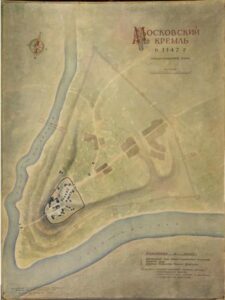
By the 13th century, the Kremlin housed the political and spiritual power of the state, with residences, workshops, churches, and state buildings all residing within its walls. In the 1360’s, Prince Dmitry Donskoy rebuilt the walls in limestone and a gleaming white Kremlin soon became the iconic image of Moscow. These walls were credited in helping the city defend itself from sieges by Grand Duke Algirdas of Lithuania in the late 1360’s.
The walls and towers that exist today are still another iteration, and were built on the order of Grand Prince Ivan III, also known as Ivan the Great, from 1485 to 1495. Ivan wanted to build something grander and more worthy of being his residence – something that would be comparable to Constantinople in terms of size and importance.
Wanting what would be specifically a “Third Rome,” Ivan invited Italian architects such as Aristotele Fioravanti and Pietro Antonio Solari. Their involvement is why the current fortress closely resembles castles of Northern Italy. Its red brick made the Kremlin unique for the time, as it was the first structure in Russia built from such material.
These brick walls have stood, with minor adjustments, since that time. One noticeable change came in the late 1600s, when Tsar Fyodor Alekseevich ordered the red brick to be whitewashed in limestone, returning it to gleaming white the city had been hitherto known for. Eventually, the whitewash stopped being maintained and was allowed to wear off, a process that was complete by the 1900s.
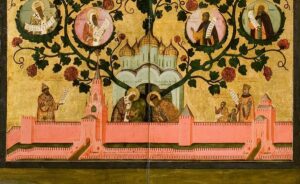
Grand Kremlin Palace Tour
By Jack Fisher
Formerly the Moscow residence of the Russian tsars, the Grand Kremlin Palace (not to be confused with the State Kremlin Palace) is a complex inside the Kremlin. It now hosts diplomatic meetings and official state ceremonies including presidential inaugurations. It is also designated as a residence of the President of the Russian Federation, but is rarely used for that purpose.
When SRAS gave me the opportunity to take an exclusive tour of this complex, which is an exclusive tour that is normally off-limits to the general public, I had to take it.
This particular tour is different from those that cover the more public areas inside the Kremlin and requires signing up early and submitting your documents for a security check.
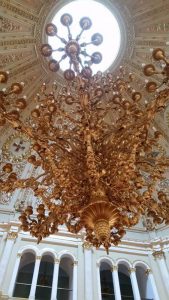
I met the tour group on a Friday afternoon in Aleksandrovski Sad, which borders the Kremlin walls. From there, we made our way towards the Kremlin grounds entrance. There was a huge line to get into the grounds through a first security checkpoint, but we were able to skip straight to the front of it since we had registered for our tour ahead of time. Once we were through the gate, the crowd thinned out significantly.
As we walked through the Kremlin grounds, we saw other tour groups taking photos of the landscaping, palace, and other historical buildings. Unlike us, they didn’t have the permission of the Russian government to enter the actual palace. When we got to the palace, we walked through the front doors, crossed a second security checkpoint, met our guide, and started the tour.
Our tour guide inside the building was a woman that worked in preservation. She only spoke Russian, so everything was translated for us by an SRAS-hired guide to English. We began on the first floor of the newer section of the palace and saw several ornate living rooms and guest rooms, followed by the empress’s and emperor’s chambers. Unfortunately, we weren’t allowed to see the emperor’s office and bathroom as President Putin had decided to use them as his personal study for the remainder of his time in office.
After the first floor, we headed upstairs to the second. From the outside the palace appeared to have three floors, but in reality the second floor just had massive, vaulted ceilings and two levels of windows. From what I saw, the second floor seemed to be where the fun happened. The first major room we walked into was the Hall of the Order of St. George, built to house major military meetings and balls and today used as a large conference room. There were names of famous military officers and soldiers inscribed on the walls, and the hall looked like it could hold hundreds of guests. Then it was on to the Hall of the Order of St. Vladimir, which was way less cool. It did, however, have the largest chandelier in the palace, for what that’s worth.
Next, we moved into the oldest section of the palace. It was built in the late 1400s and the newer sections of the palace were built out to connect with it. Our guide told us that by the time of the last czars, the older section was used strictly for ceremonial purposes. The walls were covered with paintings of historical rulers and religious figures. It was definitely my favorite room as there seemed to be an aura of timelessness hanging about the place.
Then we went back through the Hall of the Order of St. Vladimir and through another hall to the older bedchamber of the czar and an older, smaller meeting room for the czar and his nobles. This section was markedly different as there was none of the opulence of the newer palace. It had a utilitarian feel due to its practical layout with comfortable but plain looking chairs, reasonably sized paintings, low ceilings and large traditional Russian stoves.
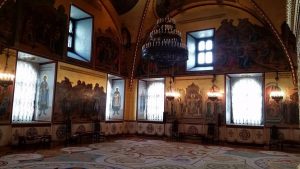
Finally, we visited the throne room. It was massive, just like the Hall of the Order of St. George, and had polished stone and gilding everywhere. Unfortunately, it was a reconstruction. Our guide let us know that the soviets had torn it apart when they came to power, creating what looked like a massive classroom to house the first meetings of the Soviet Congress. The Russian government had restored it completely within the past decade. She also let us know that the current heir to the Russian throne is Prince Harry of England, which is an interesting fact I’ve been surprising Brits with lately.
On our way out, we exited through a portrait hall. Most of the portraits were typical Enlightenment and Victorian era paintings with stuffy looking people. However, one painting caught my eye: the portrait of Knyaz Sbyatoclav. The man looked absolutely hardcore (and you can see him below in a photo I took).
In my opinion, it was definitely worth $75. While I wouldn’t go twice, the fact of the matter is that you get to see the inside of a beautiful building and stand in rooms that very powerful people meet in and have met in for hundreds of years – which is an opportunity that few regular people are given. Don’t think that it’s too expensive, because you’ll have the experience and memory with you for the rest of your life.
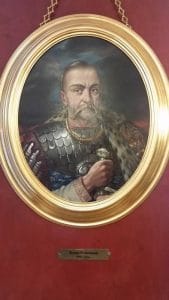
The Kremlin Without a Capital (1712-1918)
By Lee Sullivan
The Kremlin has always been a symbol of Russian power and authority. It is often used interchangeably with the Russian state in journalism and academic literature. This is not surprising considering the Kremlin is situated in the heart of Moscow and has typically housed Russian rulers and their offices – and continues to contain an official residence and office for Russian president Vladimir Putin. However, not all of Russia’s leaders have always called the Moscow fortress home. This article covers the nearly 200 years of Kremlin history when Moscow was not the capital.
Peter the Great moved Russia’s capital from Moscow to St. Petersburg in 1712. Despite the continued crowning of tsars in the Annunciation Cathedral and symbols of power in the Kremlin vaults, Moscow’s role in state life was minimal compared to that of the new capital. This changed when a new stage of construction began under Catherine the Great. Even though St. Petersburg was the new capital, she was crowned in Moscow following ancient tradition. A commission to replace the code of laws from Tsar Alexey Mikhailovich’s time was called in Moscow and its session was held in the Kremlin’s Faceted Palace. This was a sign that under Catherine the Great the state would be ruled from both St. Petersburg and Moscow. Additionally, the Senate was divided into departments under Catherine. Four were in St. Petersburg and two were in the newly commissioned Senate Building, which still stands in the Moscow Kremlin.
Catherine additionally planned a grand reconstruction of the Kremlin interior, one that would have seen most of its buildings demolished, save for the historic cluster of churches, and replaced with modern imperial architecture built with long, straight roads, much like St. Petersburg itself. Demolition was started, including to parts of the original Kremlin walls, when cracks began to appear in one of the cathedral walls due to the resulting disruption of the soil. Because of this, and because of the project’s already enormous cost, it was cancelled, and the original walls re-built.
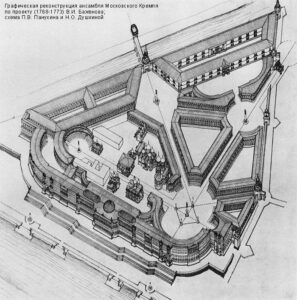
In September of 1812, French troops occupied Moscow. Napoleon, who led them, planned to occupy the Kremlin as his residence. It is widely thought that in defense against the French, the Moscow mayor ordered fires be set across the city. They raged for days so and were so intense that Napoleon was forced to leave the Kremlin due to the smoke. Upon returning he declared an intention to remain in the Kremlin for winter and ordered additional fortification of the Kremlin walls. However, the French army was weakening due to battle loss and poor supply.
Napoleon ordered his troops to retreat and blow up the Kremlin in the process. Mines were laid but their effectiveness was reduced by rain and prompt Muscovite response. Still, considerable damage was done, including to the Vodozvodnaya Tower, which was completely destroyed.
The Kremlin quickly underwent restoration under Tsar Alexander I and Nicolas I. Despite the war’s considerable drain on state funding, Tsar Alexander I prioritized restoring many parts of the Kremlin including towers, walls, palaces, and cathedrals. He often traveled to Moscow to observe the restoration progress. Many of Russia’s best architects were included in the restoration efforts. Order was progressively restored to the Kremlin and new gardens, now called the Alexander Gardens, were laid out along its exterior. Buildings like the Senate were brought back to their original appearance.
Restoration was completed under Nicholas I, who gave special attention to the restoration of ancient Kremlin churches and other old buildings. He also commissioned the construction of new buildings like the Great Kremlin Palace, after having the old one demolished. The entire imperial family attended the palace blessing during an official ceremony in April 1849. It was constructed and designed with techniques that were ahead of their time – vaulted construction for walls and ceilings, inlaid stone floors, and iron rafters.
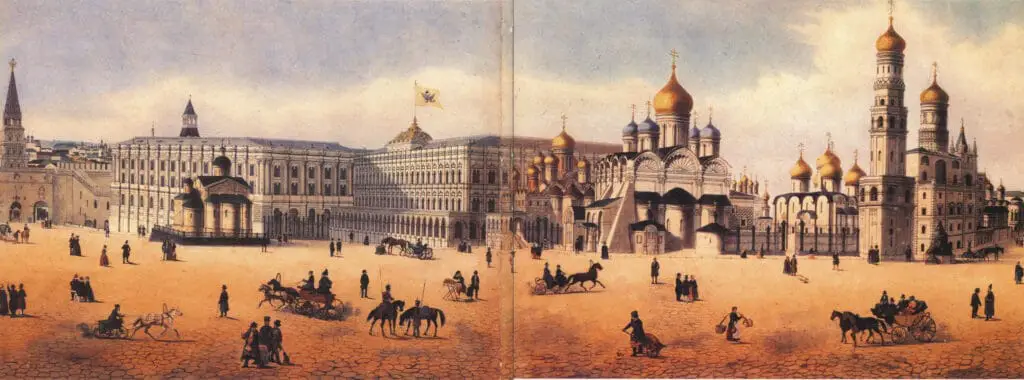
Shortly after the revolution, the Communists restored Moscow as the official capital in 1918 when Moscow was reinstated as Russia’s capital. Construction and restoration were completed by the mid-19 th century. During the Soviet years, the Kremlin housed Soviet leaders and saw the development and then dissolution of the Soviet state. Today the Kremlin stands in Russia’s capital as a unique architectural ensemble.
The Kremlin Under the Soviets
The new Bolshevik government made sweeping changes to the historic Kremlin complex to, as they saw it, better represent the character of the new socialist state.
During the revolution of November 1917, the Kremlin was ransacked, leaving it with broken glass, destroyed icons, and parts of the complex in disrepair. Restoration of the walls and towers began in 1918, but further restoration stalled for lack of funding and because the communists had not yet decided on a plan for their changes to their seat of government.
The first targets were churches and royal symbols. Nuns and monks who had long lived in the Kremlin were removed. Churches had valuables removed and transferred to the new Commissariat of Finances to fund state projects. Many royal treasures and even crown jewels were similarly transferred. The double-headed eagles on the top of the buildings were promptly removed.
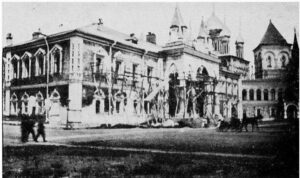
Many buildings were repurposed. Initially, many were converted to housing for Communist functionaries as the revolution and war had depleted Moscow’s housing stock while driving immigration from the countryside to the city. At one point, over two thousand people lived inside the Kremlin. By 1939, however, Kremlin residents consisted of only about three dozen high ranking officials.
Other notable repurposings included turning the Palace of Facets into a canteen with its kitchen inside the Tsarina’s Golden Chamber. The Ivan the Great Bell Tower was turned into a workshop, the Small Nicholas Palace became a worker’s club, and a gym was placed in the Church of St. Catherine. In 1932, the Andrew and Alexander Halls within the palace were gutted to make room for a party congress.
Many of the buildings and statues within the complex were destroyed, often to make way for new construction; only 26 of the original 54 buildings survived the Soviet period. The Chudov Monastery and Ascension Convent were both destroyed to make way for a military academy and eventually the Kremlin Presidium was built on the ground to house the Supreme Soviet, the supreme legislative body of the USSR.
In 1929, the Maly Nikolaevsky Palace, a former royal residence, was replaced by a new administrative building.
In the 1920s, the Russian royals buried in the Archangel Cathedral on the Kremlin’s Cathedral Square were exhumed and autopsied. They and the items in their sarcophagi were turned over to the Kremlin museum. Some valuable artifacts were requisitioned to the state treasury.
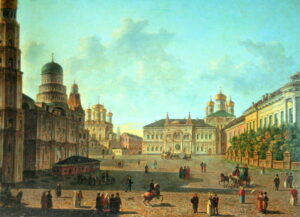
In 1935, five stars of rubied glass replaced the double-headed eagles that once topped the Kremlin gate towers.
Throughout WWII, the Kremlin was disguised under mock construction and painted roofs. Despite this, several bombs still fell on the Kremlin grounds, but did not cause major damage.
In 1947, Stalin painted the Kremlin walls red in an unmistakable ode to socialism, a drastic change from the traditional white that the walls had carried for centuries.
In 1955, the Kremlin opened to the public as an open air museum. In that same year, a ban on living in the Kremlin was introduced, lessening any security risk opening it to the public might create.
The last wave of demolitions came in 1958-1961, when the Palace of Congresses, built to house the congresses of Communist Party and cultural events, replaced the Old Amoury and part of the Patriarch’s Palace.
In part due to the outcry from this massive renovation, greater care of the Kremlin grounds began. The official Kremlin museum system was established in 1966, and Elena Gagarin, daughter of Yuri Gagarin, was hired as museum director. Today, that system includes the large armoury, several churches, and items outside of the Kremlin, such as St. Basil’s Cathedral.
The changes made during the Soviet period have left the Kremlin with a striking architectural contrast between traditional, tsarist-era architecture with Soviet-style buildings and the iconic, ancient red walls and remaining cathedrals. Despite the destruction and changes that were carried out, the compound still offers an unforgettable look into Russian and Soviet history that is impossible to get from anywhere else.
The Kremlin Stars
Translated by Caroline Barrow
The following was originally posted to the the Russian 7 website . It has been translated here by SRAS Home and Abroad Translation Scholar Caroline Barrow. Additional edits and updates were applied in 2021.
On October 24, 1935, two long-standing symbols of the Russian monarchy—the two-headed eagles which stood on top of the Kremlin towers, were ordered to be brought down and replaced with five-pointed stars.
Why a five-pointed star became the symbol of the Soviet regime is unknown, but what is known is that Lev Trotsky supported this symbol. Greatly fascinated by the esoteric, he knew that stars and pentagrams have a strong energetic potential and are one of the strongest symbols. The swastika could have easily become the symbol of the new government, since it had a strong following in Russia at the beginning of the twentieth century. Swastikas were displayed on the currency of the temporary government led by Alexander Kerensky, and swastikas were painted on the walls of Empress Alexandra Fedrovna’s Ipatiev House before the royal family was executed there. This swastika trend was stopped almost solely by Trotsky and the Bolsheviks, who opted for the five-pointed star. The history of the twentieth century even showed that stars are stronger than swastikas… Stars shone over the Kremlin, in the place of two-headed eagle.
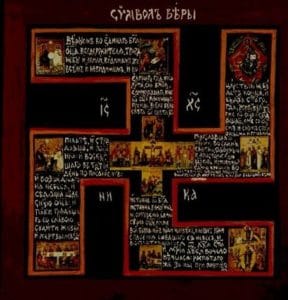
Erecting the thousand-kilogram stars on the Kremlin towers was not a simple thing to do. The problem was that the needed technology did not exist in 1935. The smallest of the Kremlin Towers, Borovitskaya, rose to 52 meters, and the tallest tower, Troitskaya, reached a height of 72 meters. Throughout the country, there were no tower cranes capable of reaching these heights. However, for Russian engineers, the word “no” did not exist, only the phrase “we must.” Engineers designed and built special cranes that could be installed on the upper deck for each tower. A metal base, called the console, was mounted at the base of each turret window, and on each console the engineers mounted a lifting crane. Thus, the process occurred in several stages: first the two-headed eagles were dismantled, and second, the stars erected.
Each star weighs about one ton. Given the height at which the stars would be placed and the fact that each star has a surface area of 6.3 square meters (potentially excellent for catching the wind), there was a danger that the stars might be blown away along with the top of the towers. So, it was decided to stress test the towers and, it turns out, with good reason: the upper part of each tower and its console was completely destroyed in the process. So, builders reinforced the masonry at the upper levels of the towers, and for the Spasskaya, Troitskaya, and Borovitskaya Tower, metal bracing was added to the base of the tower. The console on Nikolskaya Tower was so damaged that it had to be completely rebuilt.
All the stars were not made identical; four stars differ from one another in their artistic forms. On the Spasskaya Tower star, rays go out from the center. However, on Troitskaya Tower’s star, the rays look like spikes. The star on Borovitskaya Tower is made up of two contours, one inscribed in the other, and, finally, the rays on Nikolskaya Tower’s star have no pattern. In terms of length, the Spasskaya and Nikolskaya Towers were similar, with the distance between the ends of the rays being about 4.5 meters. On Troitskaya and Borovitskaya Towers, the star rays were shorter, and the distance between the ends of the rays was less, measuring 4 and 3.4 meters, respectively.
A star is good, but a spinning star is twice as nice. Moscow is large, its people many, and all must see the Kremlin stars. For the base of each star, special bearings were produced by the First Bearing Plant. These special bearings allow the stars to rotate with the wind even despite their significant weight. Consequently, it is possible to know the direction of the wind given the position of the stars.
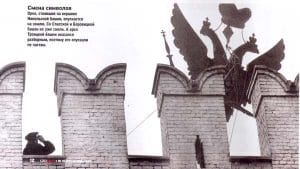
Installation of the Kremlin Stars was a true celebration for Muscovites. The stars were not carried under the cover of night to Red Square. The day before the stars were placed on the towers they were put on display in Gorky Park. District and City Secretaries of the Communist Party came together with the ordinary mortals below to see the stars. The stars were lit from the outside to make the Ural stones shine and the rays sparkle. The eagles, taken off the towers, were also displayed to visually demonstrate the dilapidation of the “old” world and the beauty of the “new” world.
The Kremlin stars were not always ruby glass. The first stars, installed in October, 1935, were made from high-alloy stainless steel and red copper. In the center of each star, on both sides, the stars were embedded with precious stones outlining the hammer and sickle emblem. Over the course of a year, the glitter of the gems dimmed. The stars were also found to be too big, not fitting well with the architectural ensemble. In May, 1937, it was decided to install new, illuminated glass ruby stars. Also, they added a star to a fifth tower, the Vodovzvodnaya Tower. The ruby glass was produced at a factory in the city of Konstantinov, according to the method of the Moscovite glassmaker, N. I. Kurochkina. It was necessary to prepare 500 square meters of ruby glass, and for that, a new type was invented—selenium ruby glass. Before that, gold was used to color the glass; selenium was cheaper and produced a deeper color.
The Kremlin stars don’t only rotate, they also light up. In order not to overheat and cause damage, about 600 cubic meters of air is blown through the stars per hour. The stars are not affected by power outages, because they have their own, independent generators.
For the original lighting, the Moscow Electrical Lamp Plant produced the lights for the stars. The stars on Spasskaya, Troitskaya, and Nikolskaya Towers all had 5000-watt bulbs, and the other two operated at 3700 watts. In each star, two parallel filaments were installed. That way, if one burned out, the other filament still shone and a control panel is was notified of the burnout.
To change a bulb, one need not need to climb up to the star. Rather, the bulb comes down on a special rod that runs straight through the bearing. The whole process takes 30-35 minutes. In the stars’ history, the stars stopped shining only twice—once during the war, and another time for the filming of the now-classic movie The Barber of Siberia .
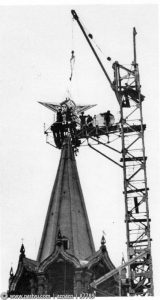
Editorial Note: Update 2021. Starting in 2015, the lighting of the Kremlin stars was updated with one star’s lighting system replaced each year. The old incandescent lamps were replaced with modern metal halide lamps. These lamps are approximately four times more energy efficient than the old bulbs and provide a more intense, higher-quality light. Metal halide lamps are often used for sports stadiums and other places where strong, high-quality light is needed.
In preparation for this switch, Employees of the Central Scientific and Restoration Design Workshops (TsNRPM) measured the illumination of each arm of each star separately to make sure that each would still be lit evenly and brightly. They also created models of the stars lit with various methods including LED matrices and optical fiber. In the end, metal halide was determined to be the closest in historical appearance to the existing incandescent lamps.
Within this update, each star was also given its first compressive maintenance since 1946. Damaged panes were replaced, the stars were cleaned inside and out, and the lubricants within the rotation system were replaced with modern fluids.
The State Kremlin Palace
By Benjamin Bradley Mulick
Finished in 1961 after three years of work, the Palace of Congresses, later renamed as the State Kremlin Palace (not to be confused with the Grand Kremlin Palace), opened its doors for the first time for the 22nd Congress of the Communist Party of the Soviet Union, welcoming thousands of party delegates as well as communist leaders from around the world. Today, it is still the Kremlin’s newest building and a multipurpose facility, housing large conventions, cultural displays from around the world and even its own ballet troupe. With these functions giving it continued purpose, the Kremlin’s most modern and out of place building is also one of its most significant.
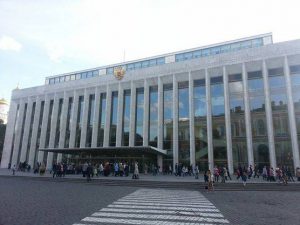
The Kremlin State Palace stands out from the gilded, pastel buildings around it with its hulking angular lines, and large windows divided by tall marble columns. It’s crowned by a glass banquet hall, which was the brainchild of Khrushchev himself.
It features three main halls: The Great Hall, the Small Hall, and the Diplomatic Hall. The Great Hall is the largest, featuring the palace’s main stage and hosting its most important events. With a seating capacity of six thousand, it is where party congresses were held, and where some of Russia’s most prominent cultural programs take place today. The Small Hall hosts smaller musical performances, and by virtue of having removable seating, also hosts dance events, such as the World Cup of Latin American Dance, as held in June of 2021. The Diplomatic Hall provides a smaller and more intimate setting in which to enjoy performances. Last but not least, the Diplomatic Hall often hosts lesser-known artists, often performing genres that do best in closer settings, such as jazz and folk.
The facility also holds many smaller meeting rooms, intended as breakout rooms for conventions, but also used for various purposes today.
The construction of the State Kremlin Palace came with considerable controversy. Not only is it stylistically wildly inconsistent with the rest of the Kremlin’s buildings, one of Russia’s most oldest and most important historical ensembles, but it also resulted in the destruction of several older buildings to make ways for the Palace’s massive presence.
The demolished buildings included the Old Kremlin Armory Building, originally built in 1851 to house the Kremlin’s ceremonial guard and a collection of state documents and treasure. The northern wing of the Patriarchal Chambers was torn down, formerly part of the private quarters of the head of the Russian Orthodox Church.
Because these were officially designated historic buildings, the legality of razing them was questionable and likely would not have taken place had not the decision been made from the office of Khrushchev himself.
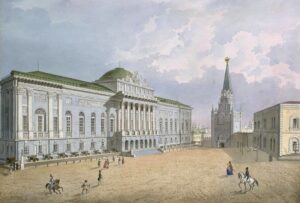
Perhaps the real loss, however, came from underground. The original plans for the palace, before the Second World War, envisioned it as truly massive facility built where Christ the Savior Cathedral now stands. In the Khrushchev era, it was planned to build a smaller but still very large building near MGU, along the river, in what were then the still-developing outskirts of the city. When Khrushchev decided to place it inside the Kremlin, its footprint was again shrunk and it faced restrictions on its height so that the view of the Dormition Cathedral would not be entirely lost.
To make up for this, the bottom part of the building was sunk sixteen meters into the valuable archeological depths of the Kremlin’s soil. The buildings torn down to make room for the Palace were themselves built over much older foundations.
Archeologists were given a short window to explore the former Palace of Natalya Narishkina, the mother of Tsar Peter I, as well the former sites of churches, royal kitchens, workshops, and studios in what was once an economic center based within the historic Kremlin.
Teams of archaeologists were assigned to the area, who, in addition to expected finds, also found a number of secret tunnels. Unfortunately, while the archaeologists did their best to learn and preserve what they could, the limited timeframe allowed by the construction of the State Kremlin Palace meant that the archaeological potential of the site was, in large part, wasted. The tunnels were filled in, the old foundations built over, and the ruins lost to history.
Today, the Palace is perhaps best known as the home of The Kremlin Ballet, which was specifically formed in 1990 under esteemed Russian artist and choreographer Andrey Petrov with the purpose of performing there after the Bolshoi Ballet stopped performing at the palace and returned to the Bolshoi, then under renovations.
While the Kremlin Ballet was created with a strong basis in the classics, they have made more recent contributions to the ballet world with a number of their own classically-inspired modern works, including a ballet adaptation of Mark Twain’s The Adventures of Tom Sawyer .
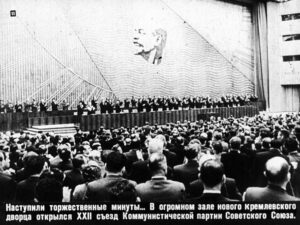
The State Kremlin Palace also hosts the Moscow Classical Ballet, which has been dancing in Moscow since 1966. Demonstrations of this tradition in the upcoming year will include the Moscow Classical Ballet’s dancing reinvention of Romeo and Juliet (which was considered scandalous when it was first performed in 1972), and a performance of Swan Lake , one of Russia’s most important contributions to dance, as performed by the Kremlin Ballet.
Built to hold important political events, the State Kremlin Palace is more a cultural building than a political one. The stage’s relatively short history promises to be subsumed by its promising future. Whatever the next big musical or cultural phenomenon in Russia is, the State Kremlin Palace will be a part of it.
- Read a review of The Snow Maidan as performed at the State Kremlin Palace on this site.
A Tour of the Moscow Kremlin Today
Tour as reviewed by Helen McHenry, 2019
As part of our SRAS cultural program, we were given the opportunity to take a tour of the Kremlin, a historic complex and symbol of the Russian government. We met our guide outside of Red Square before walking along the Kremlin walls to the visitors’ entrance. She pointed out the swallowtail merlons bordering the wall, a design popular in 15th century Italian-style architecture, before we mounted the battlement. To travel behind the Kremlin walls, we crossed a bridge that used to span the Neglinnaya River but today acts as an archway covering part of the footpath.
Inside the Kremlin is an intriguing mix of old and new – from the 15th century walls to the 20th century block of modernism known as the State Kremlin Palace. Our guide informed us of the controversy over the palace’s design, which stands in such contrast to the more traditional styles surrounding it. The building, built under Khrushchev’s leadership primarily as a government meeting hall, has almost as many floors underground as it does above ground. Although many cried out against the building when it was built, it still stands today, where it is now used mainly to host concerts.
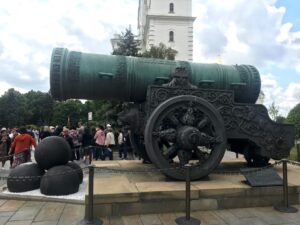
A brief walk along a path lined with cannons from the state artillery collection brought us to what appeared to be the mother of all cannons. Indeed, the Tsar Cannon is the largest bombard by caliber ever manufactured and has never been used due to its vast size. Just around the corner lay a similarly large but unused item – the Tsar Bell. Commissioned during the time of Empress Anna, niece of Peter the Great, an almost life-size image of her adorns the bell’s surface.
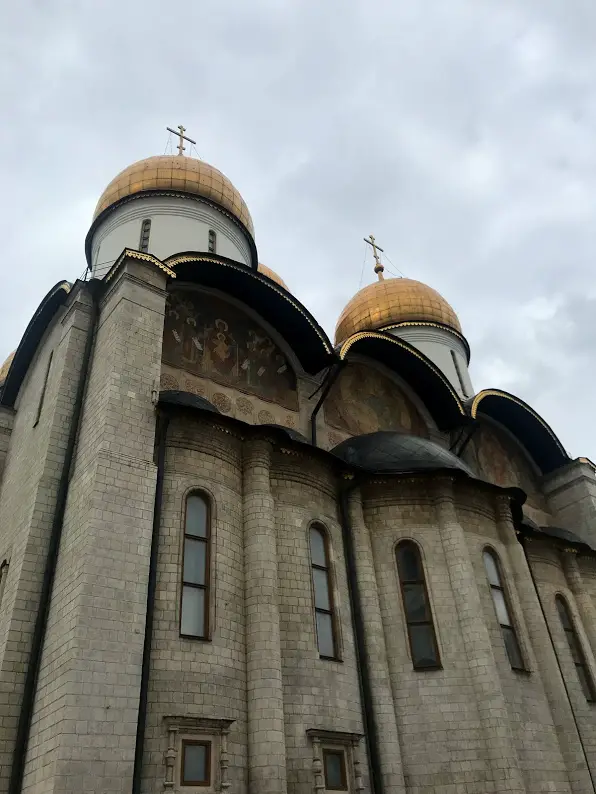
We then traveled to Cathedral Square, which, as its name suggests, features a number of beautiful cathedrals. The overcast day did nothing to accentuate the gold domes that capped their many towers, but no amount of gloom could dim their impressive stature – so immense that photographing them from my vantage point proved a challenge. Each cathedral was adorned with more stunning iconography than the last, overwhelming to the point of monotony as we shuffled through the throngs of tourists.
Our next visit was to the State Armoury, a neoclassical building resplendent with the wealth of the tsars. We traipsed through room after room of riches, from icons, dishware, and diplomatic gifts to clothing, carriages, and thrones. What stood out to me the most was the two distinct – and sometimes warring – natures of Russian identity on display at the Armoury, East and West. The contrast was particularly obvious amongst the collections of clothing, weaponry, and thrones. The older pieces hearkened back to the time before the Western pivot of Peter the Great. While these remained just as ornately decorated as their modern counterparts, they were, on the whole, a lot less outlandish than those done in the styles of the West.
The Armoury marked our last stop within the Kremlin, so we traveled across the city center to the Cathedral of Christ the Savior. Although the cathedral is the world’s largest Orthodox church, the current building is not the original. Christ the Saviour was demolished under the reign of Stalin and was only rebuilt in the late 1990s. Since then, the cathedral has gained fame as the site of Pussy Riot’s 2012 performance, which landed three members in jail for “hooliganism.”
Our guide let us explore the church on our own, as the church requires groups to be led by its own guides. Looking forward to lunch, we opted for a quick pass through the cathedral. Had I not been so hungry, I could have spent hours inside, as every surface held intricately-painted religious imagery intermixed with adornments heavily gilded with gold. Photographs were not allowed within the cathedral, reserving this spectacle to be seen first-hand.
The Kremlin in its entirety is a spot I recommend to all visiting Moscow, as four hours within its walls was not enough for our group to even scratch the surface of the wonders within.
Tour as Reviewed by Joseph Ozment, 2016
As part of SRAS’s Russian as a Second Language (RSL) program at Moscow State University, I had the opportunity to attend a guided walking tour of the Kremlin and its museums. We had a professional tour guide provided by SRAS who was very well informed about all aspects of the Kremlin’s sites and always willing to answer questions.
The tour, as offered by SRAS each session, can differ slightly based on availability and timing. We began our day’s tour not at the Kremlin, but at the nearby Cathedral of Christ the Savior, Russia’s largest Orthodox cathedral and one of the largest Christian structures in the world. Note that there are wardrobe requirements for entering the church (men and women both must have their shoulders covered, while men cannot wear shorts and women must wear skirts at least beneath the knee).
Before going inside, we were taken around the massive structure, and given a brief yet informative overview of its history. We learned that, despite the classical style of the building, it is actually only about 20 years old, having been constructed to resemble the church that once stood on the same ground.

During Communist times, the ground on which the Church now stands was a massive swimming pool, having been filled with water after the original Church was destroyed. The plans that the Communists originally had for the site were to construct the headquarters of the Communist Party of the Soviet Union, which would be one of the tallest structures in the world and house the office of the Soviet Union’s premier inside the head of a giant Vladimir Lenin statue adorning the top.
The Cathedral is a truly stunning structure. Comparable only to St. Peter’s Basilica in Rome in my mind, the sheer amount of open air is amazing when one considers how still and tranquil it is on the inside.
We then continued onwards to the Kremlin itself, which was teeming with guided tours from all over the world, just like ours. Seeing other groups from America, but also some from France, Italy, China, and several other European and Asian countries was very interesting, as people tend not to think of Russia as a popular tourist destination. However, tourism here has grown rapidly in recent years, particularly since the ruble lost about half its value on world markets, making Russia a much more affordable location.
Anna informed us of the purposes of all of the first structures we encountered within the Kremlin walls. First of all, though, she made sure that we were aware that the word “Kremlin” does not refer just the center of government in Moscow, but is a general word that means fortress. Most Russian cities and towns of reasonable size and with a medieval history possess a Kremlin.
We saw one of the offices in which President Putin occasionally works, as well as the large, semi-controversial event and concert hall that resides just inside the main entrance to the Kremlin. Despite its modern style that clashes somewhat with the comparatively ancient structures around it, the fact that the building is covered in glass at least ensures that it reflects the beauty and history that abounds within the Kremlin.
After seeing the aptly named Tsar Cannon and Tsar Bell, both of which are two of the largest objects of their kind in the world, and neither of which have been used for their structural purpose in their existence, we moved on to see several of the many churches that stand within the walls of the Kremlin.
Inside the Church of the Annunciation, we were informed of some of the basic components of any Russian Orthodox Church. For starters, every inch of wall is covered in some image or another, from icons of Saints to giant murals that depict judgment day and the people of earth being sent either to heaven or hell. We also learned that the altar in an Orthodox church is given its own room, to which only the priests are allowed entry. The mysticism that is native to Orthodoxy and inherent to its liturgy was embodied in all aspects of these churches.
After our tour of the Kremlin’s outside squares, we were taken on a tour of the Armory Museum, which houses outfits, household items, carriages, armor, weapons, and various sundry items that belonged to the Tsars and Tsarinas of Russia. Anna knowledgeably led us through the various styles worn by different Russian rulers, and explained the significance(s) behind the appearance of what they wore and the carriages in which they rode.
We were in awe of the beautiful jewels that encrusted everything the royals wore and every vessel out of which they drank or off of which they ate, not to mention of the thrones on which they sat. We saw gifts from foreign dignitaries and rulers, and even the museum’s collection of Faberge creations.
All in all, it was a day rich with history and made even more enjoyable by our friendly and incredibly knowledgeable tour guide, Anna. There is hardly a more essential Russian experience to have during your time in Moscow than a guided tour of the Kremlin.
Incidentally, Anna, a guide that SRAS has worked with for years, helps run a guiding collective in Moscow called Bridge to Moscow . They run many private tours and are available for custom tours and travel as well.
Latest Updates
By Josh Wilson
In addition to the changes to how the Kremlin stars are lit and renovations to the Kremlin bells in Spasskaya Tower , for instance, several recent events are of interest.
In the mid-2000s, the Russian Orthodox Church lobbied for the restoration of the Chudov Monetary and the Ascension Convent within the Kremlin walls. The idea was seriously considered and even discussed on television by President Vladimir Putin, although only in the sense of rebuilding them as cultural monuments and part of the museum complex, rather than as working religious institutions. In the end, however, the Kremlin Presidium was simply torn down in 2016 and the area left mostly open with fragments of the old foundations left under glass for viewing. The result is a Kremlin even more dominated by open space and gardens.
Wind has damaged the Kremlin walls on a few occasions. In June 1998, several of the iconic sparrow tail structures on the wall were damaged by strong winds. In April 2018, strong wind damaged the Senate Palace roof. In October 2021, scaffolding being used to restore a section of the inner wall was blown over the top of the wall, also damaging several of the iconic sparrow tail structures. In all cases, the damage was quickly repaired.
You Might Also Like
The Moscow Kremlin has long been the main symbol of Moscow and Russia – and for good reason. It was with the Kremlin that city of Moscow officially began and from which it grew. The Prince of Moscow, ruling from the Kremlin and drawing on the growing power of his city, united and conquered the […]
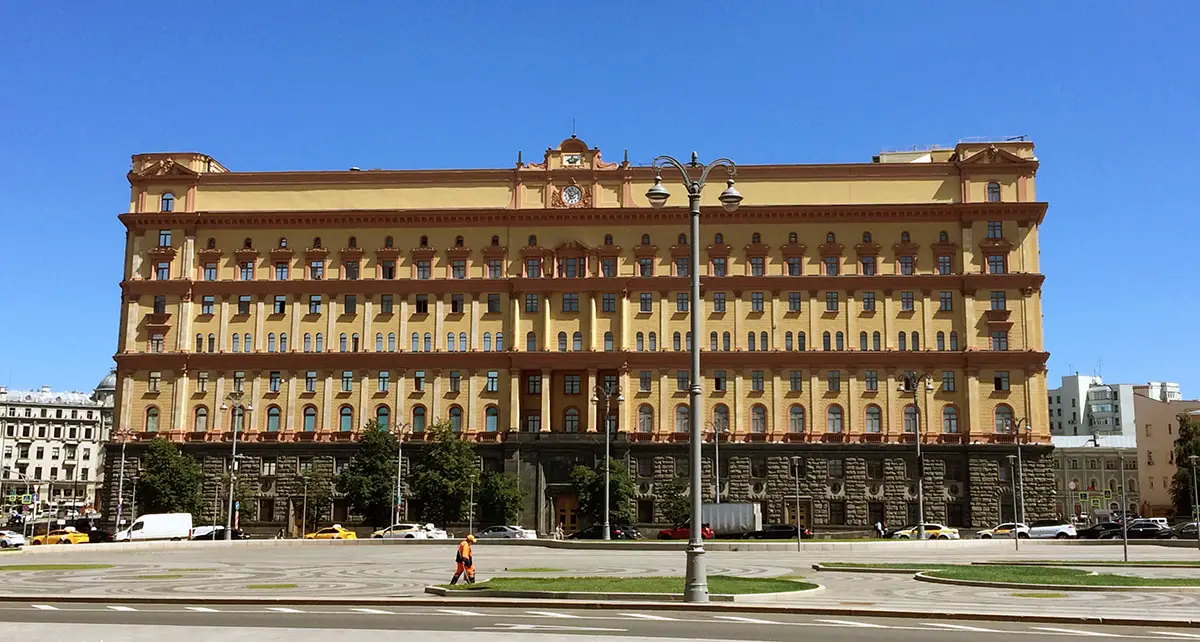
Lubyanka: Inside the Story of Moscow’s Infamous Building and District
There is always history surrounding us. In a city like Moscow, this can seem overwhelmingly apparent. Moscow has many imposing buildings from many eras – some are immediately recognizable and others only invite wonder as to what stories lay behind their beauty or grime. Lubyanka is the name commonly used to refer to the building […]
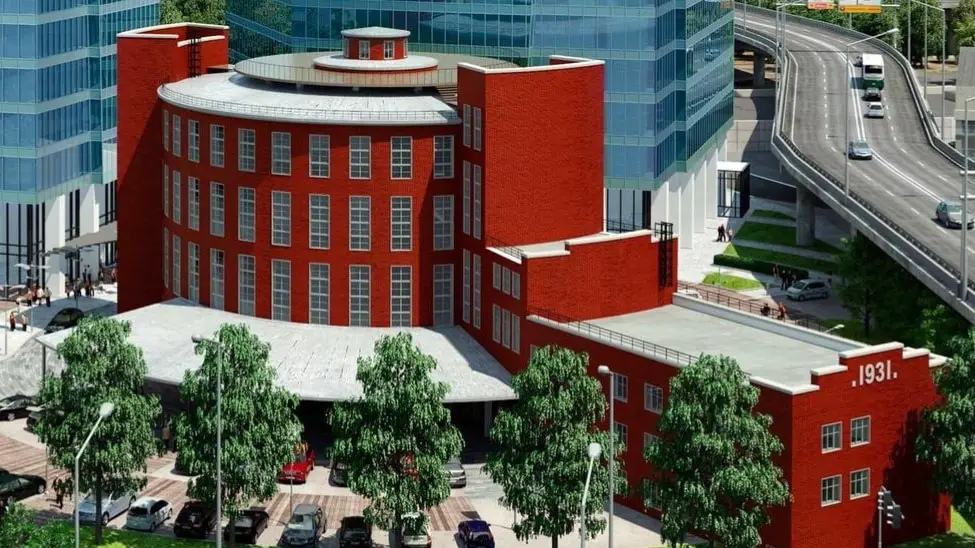
Supermetal: The Latest in Moscow’s Urban Redevelopment
By the end of 2020, the founders of Khlebozavod9 and The Brusov Ship will open a new public space near Baumanskaya metro station in Moscow. A former industrial zone will host the Supermetal Cultural and Business Complex. The team’s plans call for two architectural monuments, laboratories with panoramic windows, three courtyards, and some small manufacturing […]
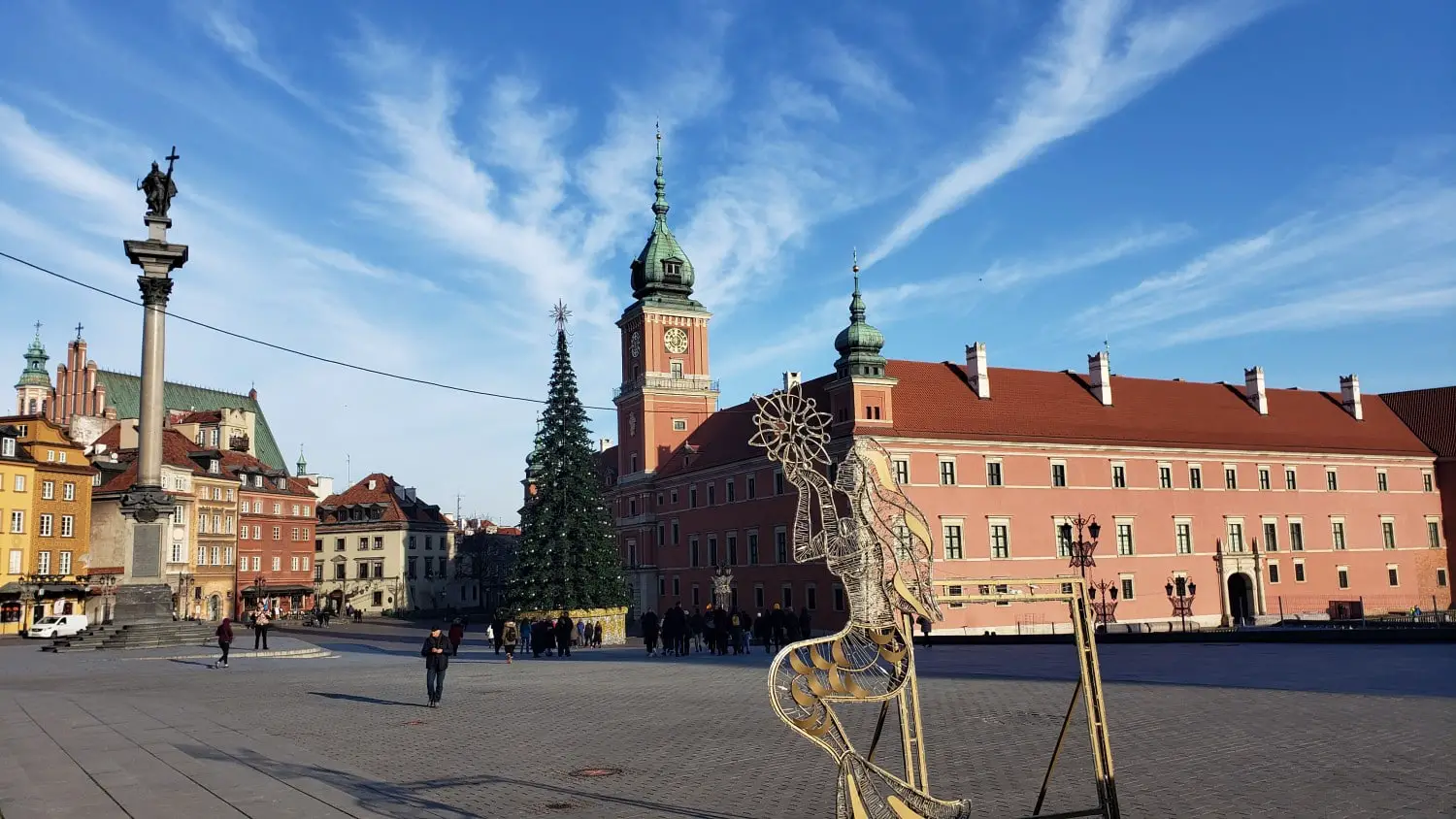
Warsaw’s Old Town District
While I was on study abroad in Warsaw, Poland, the place I visited most behind the Palace of Culture and Science, where I had classes every day, was Old Town. Why? Simply put, a trip to Old Town in Warsaw is like taking a journey back in time. It is the gem of the city […]

A Day in Tashkent’s Old City: Travel from Bishkek with SRAS
As part of SRAS’s Central Asian Studies program, students had the opportunity to travel to Uzbekistan for a full week. The first day of this week-long expedition began with a half-day tour of Tashkent’s old part of town. We were accompanied by our guide, Donat, or “Don” for short. He had outstanding English, and even […]

About the authors

Serena Keenan
At the time she wrote for this site, Serena Keenan was a rising junior at Smith College in Northampton, MA. She was majoring in Russian, East European, and Eurasian Studies with a minor in Government and a concentration in Translation Studies. She hoped to study abroad in Moscow during the spring 2022 semester. After college, she hoped to go on to work in nuclear nonproliferation. In her free time, she likes to read and crochet.
Program attended: Online Interships
View all posts by: Serena Keenan

Caroline Barrow
Caroline Barrow is a graduate of Texas A&M University with a degree in International Studies and Russian. She loves traveling and hearing people’s stories. Out of the places she’s been able to visit, her favorite was Kiev, Ukraine for its beauty, history, and friendly people. She received a Fulbright English Teaching Assistantship and, at the time she wrote for this site, was spending year teaching English in Kostanay, Kazakhstan. Additionally, she was been named SRAS’s Home and Abroad Translation Scholar for the 2013-2014 cycle. Her contributions included mostly translations of articles and blog posts that will be of interest to students.
Program attended: Home and Abroad Scholar
View all posts by: Caroline Barrow

Lee Sullivan
Lee Sullivan is an undergraduate student at Stetson University. She is currently pursuing a BS in cybersecurity and a BA in Russian, East European, and Eurasian studies. Next semester Lee will be in Vladivostok, Russia – studying the Russian language and participating in the Home and Abroad internship with SRAS. She aspires to pursue a master’s degree upon graduating.
View all posts by: Lee Sullivan
Benjamin Mulick
Ben Mulick, at the time he wrote for this site, was a fourth year Global Studies major at the University of Wisconsin–Milwaukee.
View all posts by: Benjamin Mulick
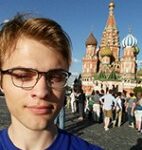
Jack Fischer
Jack Fischer, at the time he wrote for this site, was majoring in Physics with Russian and Economics minors at Iowa State University of Science and Technology in Ames, Iowa. He is studied Russian as a Second Language with SRAS over the summer of 2016 to improve his command of the Russian language. In the future, he’d like to work for himself and run a business, preferably abroad.
Program attended: Challenge Grants
View all posts by: Jack Fischer
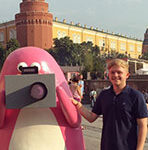
Joseph Ozment
Joseph Ozment is a fourth-year International Studies and Russian Studies major at Rhodes College in Memphis, TN. He is minoring in music minor and has spent a lot of free time on music projects. He is studying Russian as a Second Language and also working an internship with The Moscow Times. He hopes to increase his Russian skills and cultural awareness so as to use his knowledge of the country and language in a professional setting in the future.
View all posts by: Joseph Ozment
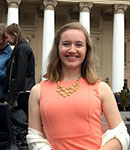
Helen McHenry
Helen McHenry, at the time she wrote for this site, was a double major in international relations and Russian at the Ohio State University, with minors in Spanish and public policy. She studied with Russian as a Second Language with SRAS at the Higher School of Economics in Moscow in order to advance her proficiency in Russian and appreciation for Russian culture. She hoped to use the knowledge gained during her time abroad to advocate for foreign policy that strengthens relations between East and West in her future career.
View all posts by: Helen McHenry

Julia Brock
Julie Brock, at the time she wrote for this site, had returned to University of Kentucky to pursue a Global Studies Certificate, with an emphasis on Russia and the travel industry. She earned prior BA and MA degrees in psychology. A few years ago, she traveled to Russia, Estonia, and Finland, and loves the culture and history of these areas. She works at the campus library, and enjoys reading, running 5Ks, and spending time with her dogs. She lived for five years in Minnesota and loved the snow, winter sports, and Museum of Russian Art.
View all posts by: Julia Brock

Hudson Dobbs
Hudson received his BA in Russian Studies with a minor in Corporate Communications from Baylor University. At the time he wrote for this site, he was serving as a Home and Abroad Scholar as part of a Spring, 2022 session of SRAS’s Language and Society program St. Petersburg. While abroad, Hudson will be researching the Russian coffee culture, as well as the evolution of specialty coffee in Russia. His goal is to open his own coffee shop in the US - taking his experiences abroad and applying them to his future business.
View all posts by: Hudson Dobbs
- Contributors : About the Site
Newgeography.com
- Urban Issues
- Small Cities
- Demographics
Moscow, like other international urban areas , is decentralizing, despite considerable barriers. The expansion will lead to even more decentralization, which is likely to lead to less time "stuck in traffic" and more comfortable lifestyles. Let's hope that Russia's urban development policies, along with its plans to restore population growth, will lead to higher household incomes and much improved economic performance.
Wendell Cox is a Visiting Professor, Conservatoire National des Arts et Metiers, Paris and the author of “ War on the Dream: How Anti-Sprawl Policy Threatens the Quality of Life ”
Note 1: The 23 ward (ku) area of Tokyo is the geography of the former city of Tokyo, which was abolished in the 1940s. There is considerable confusion about the geography of Tokyo. For example, the 23 ward area is a part of the prefecture of Tokyo, which is also called the Tokyo Metropolis, which has led some analysts to think of it as the Tokyo metropolitan area (labor market area). In fact, the Tokyo metropolitan area, variously defined, includes, at a minimum the prefectures of Tokyo, Kanagawa, Chiba and Saitama with some municipalities in Gunma, Ibaraki and Tochigi. The metropolitan area contains nearly three times the population of the "Tokyo Metropolis."
Note 2: The expansion area (556 square miles or 1,440 square kilometers) has a current population of 250,000.
Note 3: Includes all residents in suburban districts with at least part of their population in the urban area.
Note 4: Urban area data not yet available.
Photo: St. Basil's Cathedral (all photos by author)
- Login to post comments
- Evolving Urban Form: Development Profiles of World Urban Areas
- Transportation
Comment viewing options
Road in city area.
The roads and ways of the city areas are very clumsy and many accidents are happening due to the short road. But you need to maintain the driving properly otherwise you may face accident. So now the government decided to expand the road which may put the positive effect on automobile sector. I think it is a helpful service for the society people. If you have a BMW car and you have faced any problem then better to repair it at BMW Repair Spring, TX for the best service.
Transit & transportation
Transit and transportation services are quite impressive in most of the urban cities; therefore people were getting better benefits from suitable transportation service. Urban cities like Moscow, Washington, New York and Tokyo; we have found high margin of transportation system that helps to build a better communication network in these cities. I hope through the help of modern transportation system we are able to bring revolutionary change in automobile industries; in this above article we have also found the same concepts to develop transportation system. Mercedes repair in Torrance
Moscow is bursting Noblesse
Moscow is bursting Noblesse at the seams. The core city covers more than 420 square miles (1,090 kilometers), and has a population of approximately 11.5 million people. With 27,300 residents per square mile (10,500 per square kilometer), Moscow is one percent more dense than the bleach anime watch city of New York, though Moscow covers 30 percent more land. The 23 ward area of Tokyo (see Note) is at least a third more dense, though Moscow's land area is at least half again as large as Tokyo. All three core areas rely
Belgravia Villas is a new
Belgravia Villas is a new and upcoming cluster housing located in the Ang Mo Kio area, nested right in the Ang Mo Kio landed area. It is within a short drive to Little India, Orchard and city area. With expected completion in mid 2016, it comprises of 118 units in total with 100 units of terrace and 18 units of Semi-D. belgravia villas
Russians seeing the light while Western elites are bickering?
What an extremely interesting analysis - well done, Wendell.
It is also extremely interesting that the Russian leadership is reasonably pragmatic about urban form, in contrast to the "planners" of the post-rational West.
An acquaintance recently sent me an article from "The New Yorker", re Moscow's traffic problems.
The article "abstract" is HERE (but access to the full article requires subscription)
http://www.newyorker.com/reporting/2010/08/02/100802fa_fact_gessen
One classic quote worth taking from it, is: "People will endure all manner of humiliation to keep driving".
I do find it odd that the "New Yorker" article author says nothing at all about the rail transit system Moscow had, on which everyone was obliged to travel, under Communism. It can't surely have vaporised into thin air?
Moscow is a classic illustration of just how outmoded rails are, and how important "automobility" is, when the auto supplants rails so rapidly than even when everybody did travel on rails up to a certain date, and the road network dates to that era, when nobody was allowed to own a car; an article written just 2 decades later does not even mention the rail transit system, other than to criticise the mayor for "failing to invest in a transit system".......!!!!!!!!
This is also a give-away of "The New Yorker's" inability to shake off the modern PC ideology on rails vs cars.
Subscribe to NG Articles
Get new posts by email:, connect with us:.

NewGeography.com is a joint venture of Joel Kotkin and Praxis Strategy Group
Featured Content

The Coming of Neo-Feudalism

Infinite Suburbia

Recent blog posts
- Shift of Net Domestic Migration to Smaller MSAs and Outside CBSAs
- Feudal Future Podcast: Navigating the Global Politics That May Shape America's 2024 Elections
- YIMBY Can Populate Conference Halls (at Least)
- Feudal Future Podcast: Exploring the Impact of Catholic Schools on Underserved Communities
- Feudal Future Podcast: Exploring the Paradox of Peace and Economics in Taiwan-China Relations
- Feudal Future Podcast: Navigating the Future of Higher Education
- U.S. Tallest Building Set for Oklahoma City?
- Goodbye to Davos and Good Riddance
- Largest San Francisco Shopping Center Sheds Value, Tenants
- Shaving Time Off Suffolk County Homebuilding

Recent popular content
- Europe More "Auto-Dependent" Than U.S.
- We Now Join the U.S. Class War Already in Progress
- Growth and the Suburban Chassis
- Chicago Is the Duck-Billed Platypus of American Cities
- In Southern California, It Takes an Assortment of Villages
- A Capital Improvement and Revitalization Idea for Detroit
- The Demographics of Poverty in Santa Clara County
- Manhattan Ultra-Luxury ‘Battling the Serpent of Chaos’
More from this author
- Largest World Cities: 2014
- Largest Cities in the World: 2016
- World Urban Areas Population and Density: A 2012 Update
- Largest 1,000 Cities on Earth: World Urban Areas: 2015 Edition
- The Evolving Urban Form: Rio de Janeiro
Recommended Books
Blogroll and partner sites.
- Burgh Diaspora
- Center for Economic Research and Forecasting
- China Urban Development Blog
- Chris Bradford - Austin Contrarian
- Houston Strategies
- LA Observed
- Multiplier Effect: Levy Economics Institute
- The Rural Blog
- The Urbanophile
- Request new password
- © 2024 New Geography
- CONTRIBUTORS :
- PRIVACY POLICY
- Stay up to date:

Middle East Crisis Truce Talks Expected to Resume in Egypt
- Share full article

Cease-fire negotiations are set to resume in Cairo.
An Egyptian state-owned TV channel, Al Qahera News, reported on Saturday that negotiations on a cease-fire in the war between Israel and Hamas were expected to resume on Sunday, citing an Egyptian security official.
A senior Israeli official, who spoke on condition of anonymity to discuss sensitive diplomatic matters, confirmed that an Israeli delegation was scheduled to depart for Cairo on Sunday to participate in the talks.
More than 32,000 Palestinians have been killed over the course of the five-month war between Israel and Hamas, according to Gazan health officials, and negotiations to pause the fighting and release the hostages held in Gaza have been stalled for months.
Hamas said last Monday that it had rejected an Israeli counterproposal. Talks have been at an impasse because of disagreements over an Israeli withdrawal, the return of displaced Gazans to their homes and the details of an exchange of hostages for Palestinian prisoners, among other points.
Egypt, Qatar and the United States, Israel’s staunch ally, have played the role of mediators in previous rounds of negotiations, with the two Arab nations serving as go-betweens with Hamas leaders. So far, however, a workable agreement has eluded all sides.
The mediators had pushed hard to secure a cease-fire before the start of Ramadan, but the Muslim holy month is more than half over.
Many experts have said that a cease-fire is necessary to significantly increase the level of aid flowing into Gaza and stave off a possible famine.
Last Monday, the United Nations Security Council passed a resolution calling for an immediate cease-fire in Gaza and the “immediate and unconditional release of all hostages.” In a shift from its previous ironclad support for Israel, which has argued a cease-fire would allow Hamas to remain in power, the United States abstained from the vote and let the measure pass.
Talks have been held in Cairo and Doha, Qatar, where Hamas leaders have a presence, and the top mediators and Israel have met in Paris at least twice.
One sticking point in the cease-fire talks had recently been the number of Palestinian prisoners to be released, in particular those serving extended sentences for violence against Israelis, U.S. and Israeli officials have said.
— Vivian Yee and Adam Rasgon
Aid is slow to enter Gaza, despite top U.N. court ruling demanding ‘unhindered’ access.
When Christopher Lockyear, the secretary general of the aid group Doctors Without Borders, visited the Gaza Strip for five days earlier this month, he took note of the miles of trucks waiting to deliver aid into the devastated enclave despite mounting international pressure to increase shipments.
On Thursday, the International Court of Justice in The Hague reacted to the continuing problems by ordering Israel to ensure the “provision of unhindered aid” into Gaza, using some of its strongest language yet. Israel has rejected accusations that it is responsible for delays in delivering aid, and it did so again this week.
The amount of aid reaching Gaza has fallen sharply since the start of Israel’s war with Hamas . Months of bombs and street fighting have devastated entire neighborhoods; and experts continue to warn that Gazans unable to escape the war are facing a looming famine .
“It’s not just about the number of trucks coming in the border,” Mr. Lockyear said in an interview on Saturday. “It’s about what happens after that point. It is about the delivery. It is about sustained health care. It is about clean water.”
In its ruling on Thursday, the I.C.J., the United Nations’ highest court, called on Israel to increase the number of land crossings for aid and demanded that it ensure its military doesn’t violate Palestinians’ rights under the Genocide Convention, “including by preventing, through any action, the delivery of urgently needed humanitarian assistance.”
Israel’s Foreign Ministry responded by saying that Israel had gone to great lengths to mitigate harm to civilians and to facilitate the flow of aid into Gaza, “including in particular food, water, shelter equipment and medicines.”
On Oct. 9 — two days after the Hamas attack into southern Israel and the start of Israel’s war in Gaza — Israel imposed what it called a “ complete siege ” of the territory. Since then, aid has been allowed into Gaza only under restrictive measures that Israel controls; those rules also apply to aid sent by the United Nations and groups like Doctors Without Borders, which is known by its French acronym M.S.F.
This week, Mr. Lockyear said, an M.S.F. truck carrying medical supplies and equipment was prevented from entering Gaza because it was carrying metal devices that are used to help set broken bones. “These items, which were formerly approved to go in, we have got them into Gaza previously,” Mr. Lockyear said. This time, he said, “the whole truck was turned around because these items were there, and we don’t know why.”
A spokeswoman for the Israeli authority responsible for allowing aid into Gaza said the authority could find no record or information about an M.S.F. truck being rejected or refused.
Israel has previously said that it prevents or restricts entry of what it calls “dual-use” items — materials or items that it says Hamas could use for military purposes.
Mr. Lockyear said his five-day visit to Gaza, both in the southern city of Rafah as well as Deir al Balah in the central part of the territory, underscored for him the crucial importance of not only ensuring that sufficient aid gets into Gaza and is properly and safely distributed, but also the need to end the conflict itself.
The compounding effects of the humanitarian disaster and the continued military operations came into focus, he said, during a visit to Al Aqsa Hospital in Deir al Balah on March 19, the morning after the area endured another heavy bombardment.
The wards and corridors were full of wounded victims with burns, shrapnel wounds and crushed limbs, including some in need of amputation. Meanwhile, a steady stream of weak and bony children suffering from malnutrition were being brought in.
“One of the most shocking things there is the decision that the medical teams there were having to make, in terms of: Do they give beds to trauma patients, or do they give beds to malnourished kids?” he said.
On Saturday, the director general of the World Health Organization, Tedros Adhanom Ghebreyesus, called for increased evacuations out of Gaza. With battered hospitals struggling to care for the sick and injured, he wrote in a post on X , “around 9,000 patients urgently need to be evacuated abroad for lifesaving health services, including treatment for cancer, injuries from bombardments, kidneys dialysis and other chronic conditions.”
He urged Israel to approve more evacuations, saying, “Every moment matters.”
— Raja Abdulrahim
Advertisement
Charity that made first delivery of food to Gaza by sea sends a second load of aid.
A second load of aid from the World Central Kitchen left Cyprus for Gaza on Saturday, an even bigger batch of badly needed food for Palestinians at imminent risk of famine.
A vessel, called the Jennifer, and other barges were carrying almost 400 tons of shelf-stable and ready-to-eat items like rice, pasta, flour, canned vegetables and proteins — double the amount delivered in the World Central Kitchen’s first shipment to Gaza in mid-March, the charity said in a statement. The United Arab Emirates also contributed a shipment of dates, which are often eaten to break one’s fast during Ramadan, the holiest month of the Muslim calendar. There is a little more than a week until Eid al-Fitr, the Islamic festival that celebrates the end of the holiday. This year it is expected to fall on or near April 9.
It was not clear when the second shipment would arrive, but the first vessel, called the Open Arms, took about four days to reach Gaza after leaving Cyprus. The Jennifer was also carrying two forklifts and a crane to offload cargo.
Delivering aid by sea is one of the latest international initiatives to stave off the threat of starvation in Gaza, where aid has been limited to tightly controlled border crossings.
When the first vessel arrived in Gaza, José Andrés, the Spanish American chef who founded the World Central Kitchen, said distribution efforts would start in northern Gaza, where violence and lawlessness has hindered food distribution efforts. Arriving at a newly built jetty on the coast, south of Gaza City, it was the first vessel authorized to deliver aid to Gaza in decades.
The United States has also announced a plan to build its own temporary floating pier to bring aid into Gaza, but it could take weeks to build.
A recent report from the Integrated Food Security Phase Classification global initiative, the global authority on famine and nutrition, found that the food shortages driven by the war were so severe that northern Gaza might reach a famine anytime in the coming months.
A famine is defined when an area meets three criteria: At least 20 percent of households have an extreme lack of food; at least 30 percent of children suffer from acute malnutrition; and at least two adults, or four children, for every 10,000 people die daily from starvation or from disease linked to malnutrition.
The process of getting aid into Gaza by land is long and convoluted, with trucks facing delays and difficulties at every stage of the distribution process. Roads ruined by Israel’s bombardment of Gaza make it difficult for trucks to traverse northern Gaza; aid agencies such as the World Food Program have suspended their deliveries there, citing security concerns.
The U.N. agency for Palestinians, known as UNRWA, says that Israel has prevented aid from entering at the necessary pace with its slow inspections. COGAT, the Israeli unit that supervises deliveries into Gaza, points the blame at the aid groups for not distributing aid fast enough.
— Gaya Gupta

IMAGES
VIDEO
COMMENTS
Explain the relationships among power, authority, and legitimacy. Discuss political history and contemporary political and legal developments surrounding governing regimes. A government can be defined as a set of organizations, with their associated rules and procedures, ...
Authority is the power to influence opinion, behavior, and thought. Power is the capacity to influence the behavior of others. Legitimacy involves acceptance of an enforced law as an authority, whereas power involves persuading others to do something. Power becomes an authority after getting legitimized; thus, it is more effective.
power, authority and legitimacy together, it is no wonder ambiguity prevails.9 Weber's is not the only or last word on the subject, but it is a laid claim to great rigor in Who Governs: Democracy and Power in an American City (New Haven, CT: Yale University Press, 1961), but was no more careful to distinguish power from authority.
Nicholas Mtetesha. Authority, power and legitimacy are seen as an integral part of the human society for the simple reason that these are the defining features of a a social being with social and political institutions and hierarchies. Many scholars have sort to propound these concepts but not has so extensively influenced the concept as max ...
Authority is the legitimate or socially approved use of power that a person or a group holds over another. Legitimacy is vital to the notion of authority; legitimacy is the main means by which authority is distinguished from more general notions of power. Power can be exerted by the use of force or violence.
In conclusion, the key concepts of politics are analyzed in this essay, such as power, legitimacy, and authority. Success in getting elected to political office confers power and authority on individuals. Politics has a huge impact on our lives and everything we do. ... Power, Legitimacy & Authority: Key Concepts in Understanding Politics ...
Legitimacy. To be in a position to exercise authority. Links to power and authority by transforming the former into the latter - turns naked power into authority. Moral right to rule - Locke and consent - social contrast theory - we consent to be governed. If there is a formal constitutional basis, we can see legitimacy.
Rational-Legal Authority. If traditional authority derives from custom and tradition, rational-legal authority derives from law and is based on a belief in the legitimacy of a society's laws and rules and in the right of leaders to act under these rules to make decisions and set policy. This form of authority is a hallmark of modern democracies, where power is given to people elected by ...
Legitimacy, Authority and Power: Some Key Concepts in the Understanding of Contemporary Societies ... 2000, is a collection of essays addressing definitions of legitimacy in different settings, i ...
Authority, closely related to power, denotes the legitimate right to command and control. It implies the sanctioned use of power, acknowledging the consent of those under its influence. Unlike power, which can be seized or imposed, authority is granted through formal means or societal norms, reflecting the acceptance of the governed.
The Concepts Of Power, Authority & Legitimacy. Categories: Authority Philosophy Power. Download. Essay, Pages 4 (768 words) Views. 1382. The political arena in modern times is often times fraught with dissension, treachery and agendas which are set in place only to forward individual means. These circumstances are not coincidental or without ...
Power is the capacity to exert influence or control over others. It can appear in various ways, including physical strength, wealth, information, or persuasive abilities. On the other hand, the term "authority" refers to the legitimate right to use force. It is drawn from the approval and permission of the governed.
Modern thinking about legitimacy has been greatly influenced by Max Weber. According to Weber, legitimate authority generates compliance by inspiring in people a belief that authority should be obeyed (Blau, 1963; Weber, 1958; Williams, 2003).That is, legitimacy fosters a feeling of an internal sense of moral obligation to obey authority. Weber's analysis of legitimacy was systematically ...
Power is an entity or individual's ability to control or direct others, while authority is influence that is predicated on perceived legitimacy. Max Weber studied power and authority, differentiating fbetween the two concepts and formulating a system for classifying types of authority.
This essay considers how the tensions inherent to authoritarian politics structure urban governance in the city of Moscow. The focus here is on urban development policy and the housing renovation programme introduced in 2017. ... The tension dated back to Putin's ascent to power and the competition between the pro-Putin Unity Party (Edinstvo ...
In their seminal essay 'The Two Faces of Power' ([1962] 1981), P. Bachrach and M. Baratz described non-decision-making as the 'second face of power'. ... Introduction Power Authority Legitimacy Summary Further reading. Introduction. All politics is about power practice of politics is often portrayed as little more than the exercise of ...
There are a few key distinctions between power vs. authority: 1. Source: Power is one's ability to influence people, and personal characteristics can contribute to a person's power. Authority figures do not need charisma to hold legitimate power and formal rights, but there can be crossover. A president, for example, holds a position of ...
Summary. During the century following the Mongol invasion and subjugation of the Russian lands to the Golden Horde the princes of Moscow, the Daniilovichi, gained prominence in north-eastern Russia. By winning the favour of the khans of the Golden Horde they were able to break dynastic traditions of seniority and succession and become the grand ...
Asian J. Management 2 (4): Oct.-Dec., 2011 page 204-206. Power, Authority and Legitimacy. Kamalnath Nayak*. Hidayatullah National Law University Raipur (C.G.) *Corresponding Author E-mail: [email protected]. In political science, legitimacy is the popular acceptance of a governing law or regime as an authority.
Power and Authority, Legitimacy. By Stacey Ellis. The idea of Authority is to look at two other concepts that give authority its meaning, such as power and if that is legitimate. In order to have Authority over something or someone you must have its power and how it is able to influence the person this can be used through manipulation or ...
Block-4 Power, Authority and Legitimacy-2017: Unit-14 Power and Authority-2017: Unit-15 Legitimacy-2017: Unit-16 Political Obligation and Revolution-Collection's Items (Sorted by Submit Date in Descending order): 1 to 4 of 4 Discover. Date issued. 3 2017; 1 2020; Has File(s) 4 true
The Kremlin has always been a symbol of Russian power and authority. It is often used interchangeably with the Russian state in journalism and academic literature. This is not surprising considering the Kremlin is situated in the heart of Moscow and has typically housed Russian rulers and their offices - and continues to contain an official ...
The Evolving Urban Form: Moscow's Auto-Oriented Expansion. by Wendell Cox 02/21/2012. Moscow is bursting at the seams. The core city covers more than 420 square miles (1,090 kilometers), and has a population of approximately 11.5 million people. With 27,300 residents per square mile (10,500 per square kilometer), Moscow is one percent more ...
Cease-fire negotiations are set to resume in Cairo. Destroyed buildings in the Gaza Strip on Friday. Hussein Malla/Associated Press. An Egyptian state-owned TV channel, Al Qahera News, reported on ...